Finding the Universe
Travel tales, photography and a dash of humor
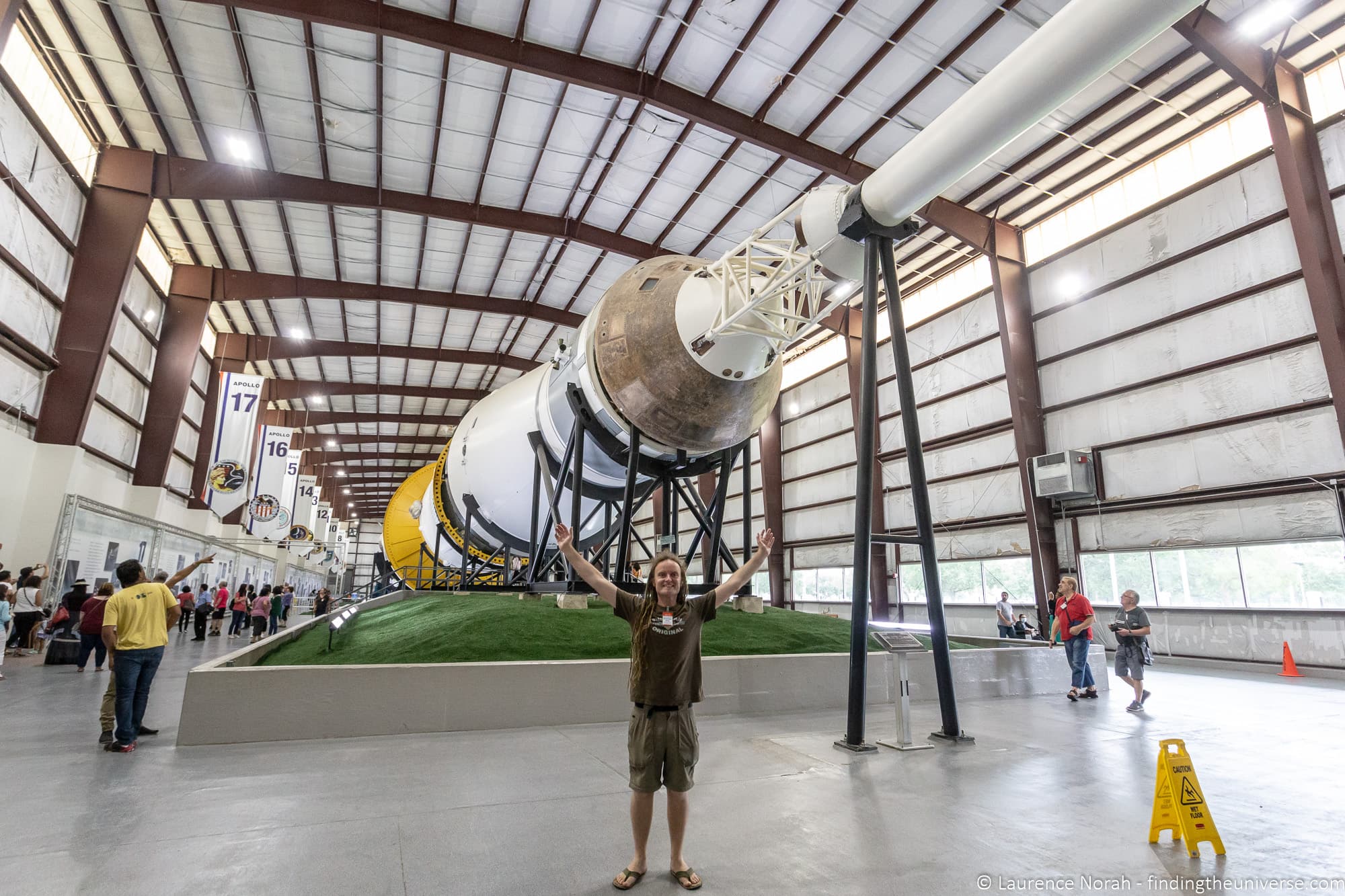

Guide to Visiting Space Center Houston, Texas
Last updated: December 16, 2023 . Written by Laurence Norah - 8 Comments
If you are visiting Houston in Texas, one attraction we can highly recommend you spend some time at is the Space Center Houston.
Space Center Houston is the official visitor center of the NASA Johnson Space Center, which is the home of NASA’s Mission Control and where U.S. astronauts are trained. It’s also a Smithsonian affiliate museum.
There are two main parts to a visit to the Space Center. There’s the large self-guided Space Center museum itself, which is home to numerous exhibits on space exploration and space in general.
Then there’s the tram tour, which takes you onto the grounds of the NASA Johnson Space Center facility itself, where you can see actual working government facilities, as well as historic locations like the original Mission Control room.
In this post, we’re going to share everything you need to know to make the most out of your visit to Space Center Houston, from getting there, to what to see and do, to how to save money on your ticket.
Let’s get started.
A Guide to Visiting Space Center Houston
Where is space center houston.
Space Center Houston is at 1601 E NASA Parkway. This is found around 26 miles southeast of the city center, or approximately a 30-minute drive in light traffic.
How To Get to Space Center Houston?
From Houston, the easiest way to get to Space Center Houston is to drive. You can just follow the I-45 out of the city centre, and then take exit 24, following signs for NASA. It should take around half an hour, although of course traffic can slow you down. There is a large car-parking lot on site, with a reasonable daily fee of $5 per vehicle.
During the week it is also possible to take public transport to Space Center Houston, using Bus service 249. This takes around an hour and costs $3. You can see schedules and timetables on the Houston Metro site . Public transport is not available on the weekends.
There is a Hop-on Hop-off bus service in Houston , but it does not go to the Space Center.
You can also take a taxi or ride share service like Uber. Prices will vary, but will be in the region of $30 – $60 each way depending on traffic and time of day. You can also get these back from the Space Center.
Finally, it’s also possible to take a guided tour from the city centre out to Space Center Houston. As an example, this tour includes a tour of Houston, transport to and from Space Center Houston, as well as entry to the Space Center.
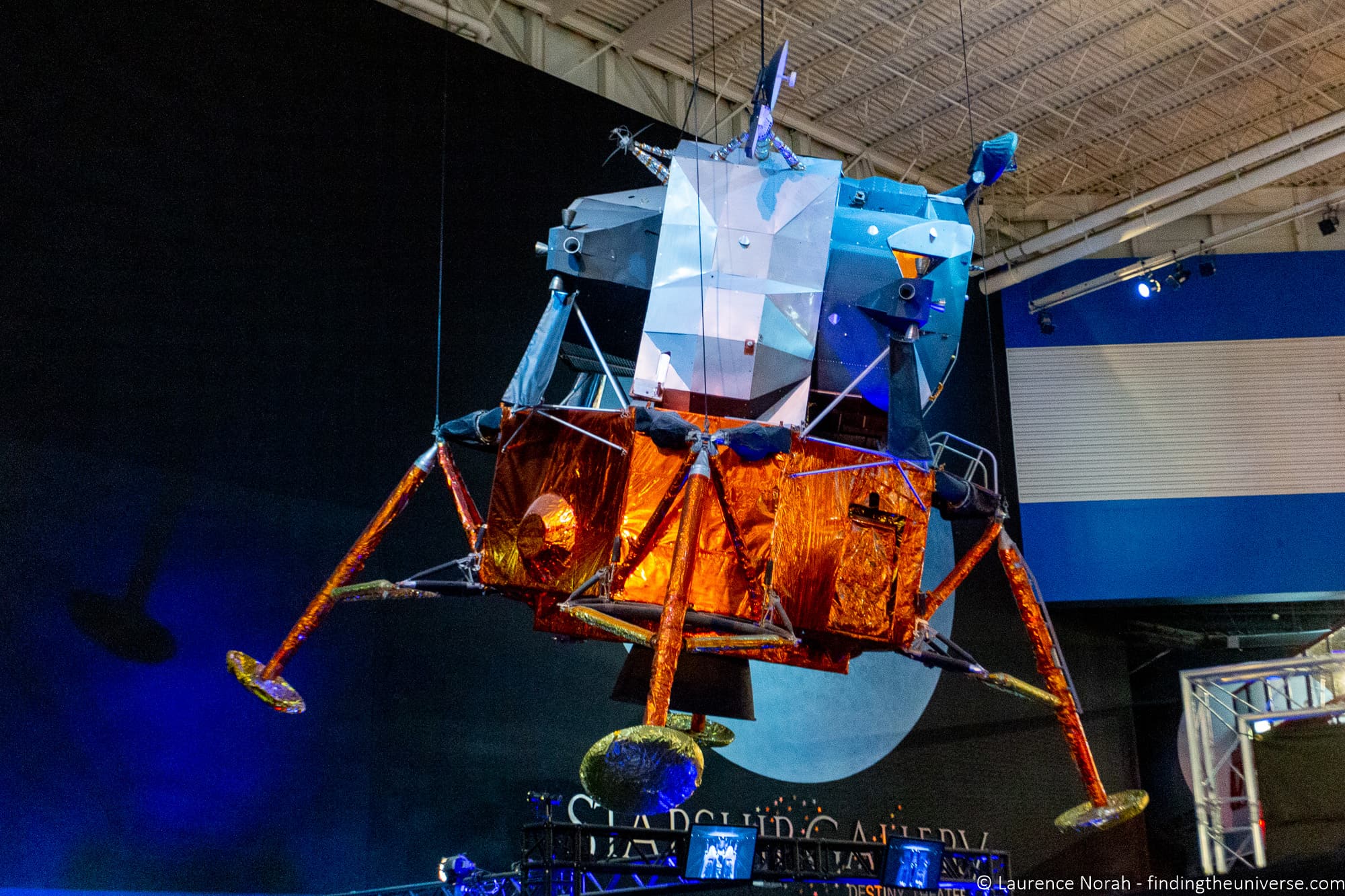
How Much Does it Cost to Visit Space Center Houston?
Standard entry to Space Center Houston for an adult (12+) is $29.95 – $34.95 depending on the day and time you visit. It’s $24.95 for children (aged 4-11) and $27.95 for seniors (65+). Prices are correct as of February 2023.
There are a variety of discounts available for active and retired military with I.D., AAA members with I.D., and groups. Children 3 and under are able to enter for free.
You can see all the details of the pricing and discount eligibility on the official site here . Note, tickets bought on the official site are non-refundable. You can also buy your ticket online in advance here for the same price , with the option of free cancellation up to 24 hours in advance of your visit.
You can also buy tickets in person. The price is the same, but if you print your ticket at home or download it to your mobile device, then you can skip the ticket line and go straight to the entry turnstile. This can save you a bit of time on busy days.
Space Center Houston is also included on the Houston City PASS . This can save you significant money if you plan on visiting some of the other attractions that the pass covers – up to 50% savings in fact! We found the pass very useful for our trip to Houston.
The Houston City PASS includes entry to five of Houston’s most popular attractions, but you only need to visit two or three of them for it to start saving you money.
See what it covers and buy yours in advance here . You can also buy it here with the option to cancel up to 24 hours before your trip if you need the flexibility.
Note – the CityPASS includes the standard tram tours but not the Mission Control tram tour, which is a paid extra. Last time we checked in 2023, you can upgrade on site for $15, subject to availability.
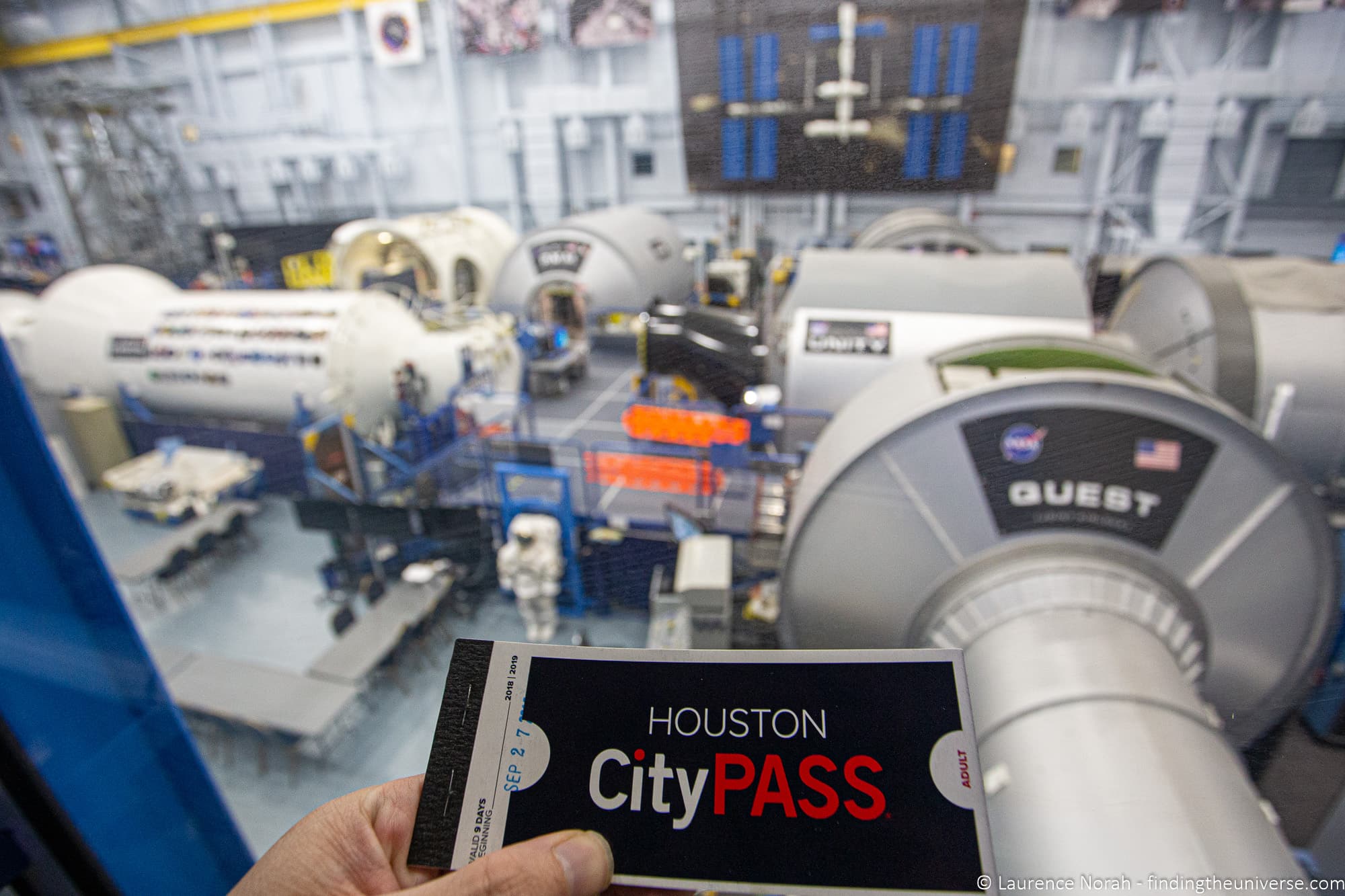
Are there different ticket types and experiences at the Space Center?
There are a number of different ticket options for Space Center. These are:
- the standard ticket
- the standard ticket with Mission Control Tour
- the Breakfast with an Astronaut Experience
- the VIP tour
The difference between these tours is reflected in the experience you have as well as the price you pay. See below for more on what each of these tickets includes and the difference between them, as well ar pricing.
Ticket types for Space Center Houston
The standard entry ticket gets you access to all the exhibits in the Space Center as well as the tram tour of NASA Johnson Space Center. This is the ticket included on the Houston City PASS . This costs $29.95 – $34.95 for an adult.
The standard entry ticket with Mission control tour . This is the same as the standard entry ticket but it also includes the Mission control tram tour. This costs an extra $15 per ticket, so for adults it varies from $44.95 – $49.95.
The breakfast with an astronaut experience. This includes your standard entry, plus, as the name suggests, you get to have a meal with an astronaut. You’ll hear stories and anecdotes from an actual NASA astronaut, plus have the opportunity to take photos.
This is only available once or twice a week, and it depends on astronaut availability. This experience needs to be booked in advance, and you can find out more here about availability and what it includes. It currently costs $99.95.
Finally, the NASA VIP Space Center Houston tour is the ultimate VIP experience, for those who want a truly unique and special experience. The highlight of this experience is a 3 hour guided tour of the NASA Johnson Space Center, giving you much more access than the tram tour.
The VIP costs $199.95, and the includes your entry to Space Centre Houston, so you have plenty of time to see everything. The tour needs to be booked in advance, which you can do here . It is only available for those aged 14 and older. Tours run twice a day, one in the morning and one in the afternoon. They actually visit different locations, so you could book both for the ultimate experience!
Experiences at Space Center Houston
As well as the different ticket options, Space Center Houston also offers a variety of educational programs geared to families and children’s organizations and groups (e.g., Boy Scouts, school groups).
For example, they offer a number of overnight experiences, including a family oriented overnight experience. This gives you the opportunity to actually stay overnight at the facility, either in your own tent outside, or inside amongst the artefacts.
You can see all the upcoming events and experiences on the events page here .
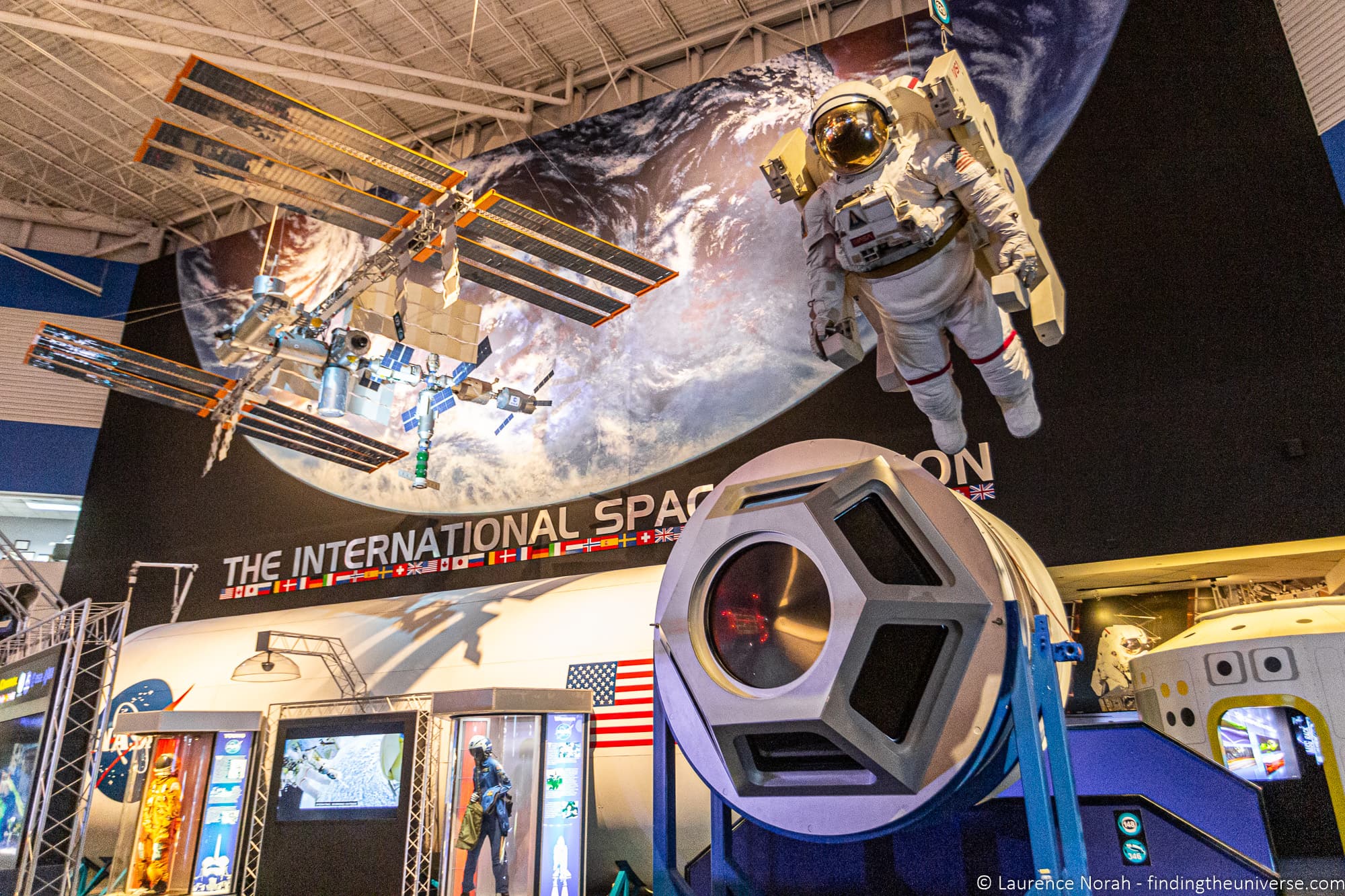
What can you do at Space Center Houston?
There is a lot to do at Space Center Houston, with over 400 space artifacts, a number of permanent and temporary exhibitions, learning experiences, theaters, and more!
Here’s a quick overview of the major attractions and activities you can enjoy at Space Center Houston. It’s not absolutely everything, but it should give you an idea of the scope of what’s on offer!
The NASA Tram Tour at Space Center Houston
This tour of the NASA Johnson Space Center takes you to some of the highlights of the Johnson Space Center, and is one of the most popular parts of a visit to the Space Center.
The tour may change depending on what’s happening at the facility and security considerations with active missions and programmes, but it normally has the option to visit one or more of the following, depending on the time of year and tram tour chosen:
- The Mission Operations Control Room 2, commonly known as Mission Control, which was where the Apollo missions were coordinated from.
- The Space Vehicle Mockup Facility, where astronauts train on replicas of space vehicles like the ISS.
- Rocket Park, home to a Saturn V rocket (the size has to be seen to be believed) as well as a number of other rockets from different stages of the space program.
We have more detail on the tram tour in the section dedicated to taking the tram tour elsewhere in this guide.
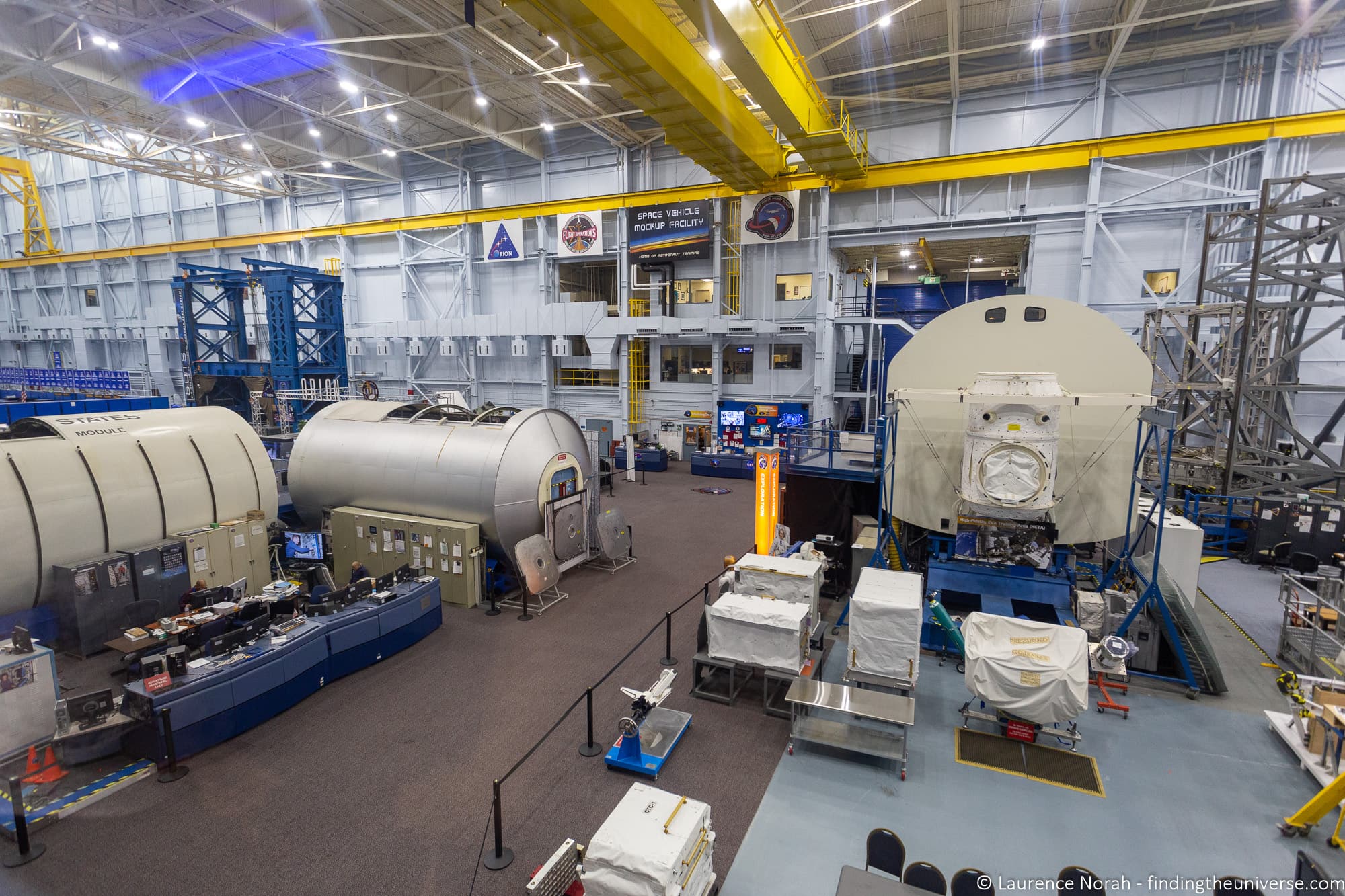
Independence Plaza
Independence Plaza is a large space outside the main Space Center building. It is home to an actual Boeing 747 aircraft, atop which is mounted a replica space shuttle.
The 747 in question was one of two Shuttle Carrier Aircraft developed by NASA to transport the space shuttle from it secondary landing site back to the main Shuttle Landing Facility at the Kennedy Space Center.
Often, bad weather would prevent the shuttle from landing at Kennedy, and so the 747 was developed to transport it back.
At Independence Plaza you can go all the way up into the replica shuttle, as well as through the length of the 747, where there are a variety of exhibits and interactive installations, telling the story of the vehicle.
Starship Gallery
Inside the main Space Center building, one of the most impressive galleries in our opinion is the Starship Gallery.
This is home to three actual spacecraft which have flown to space, the Mercury 9 capsule, the Gemini 5 capsule, and the Apollo 17 command module.
There’s also a lunar module test vehicle, a lunar rover test vehicle, a full-scale Skylab trainer and more.
Finally, the Starship Gallery is home to an actual piece of lunar rock, which is one of only eight in the world that you are allowed to touch. Yes, you can touch a piece of the moon in the Starship Gallery!
Mission Mars
One of the newest exhibits at the Space Center is Mission Mars. This exhibit focuses on NASA’s project to ultimately send manned space missions to Mars.
It covers the various challenges that need to be overcome for that to be successful, the vehicles that are being developed to take us there, and an overview of humanity’s relationship with the red planet.
There are also galleries explaining what life on Mars might be like when we finally send people there, including the habitats, clothing, and equipment that might be used.
This is a very interactive exhibit, with lots of touchscreens and hands on opportunities. You can also touch a Mars meteorite here.
Astronaut Gallery
The astronaut gallery is a display of astronaut clothing and spacesuits that have been on real-life missions.
Some of the highlights of this gallery include Pete Conrad’s Apollo 12 suit, Michael Collins’ Apollo 11 garment, and Wally Schrira’s Apollo 7 suit.
However, there are a great many wonderful exhibits here, spanning all of NASA’s space flight programmes. There is also the crew wall, which features portraits of every NASA astronaut who has flown in space, from Alan Shepherd and Neil Armstrong up to those currently in orbit on the International Space Station.
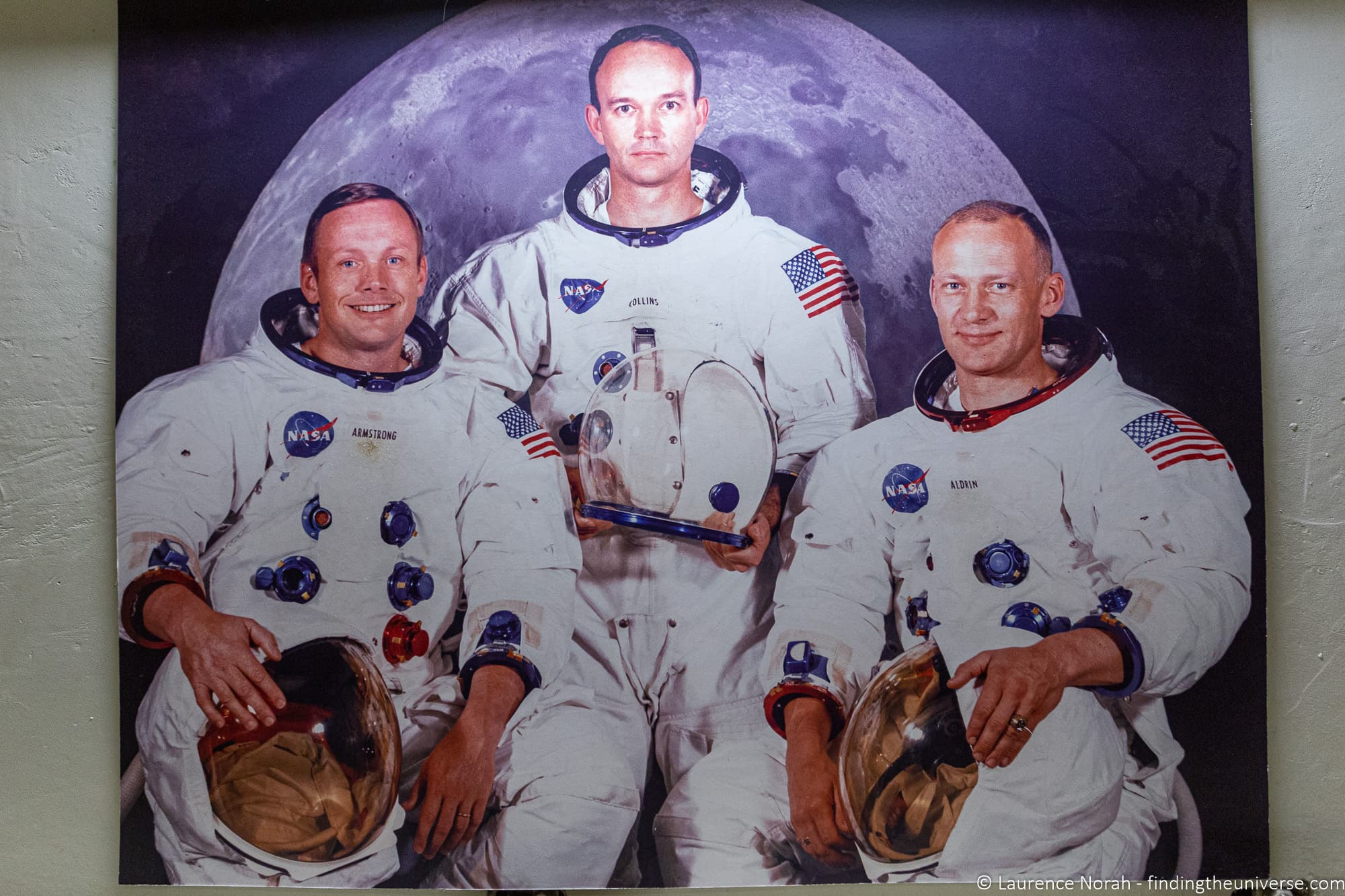
International Space Station Gallery
The International Space Station (ISS) is one of mankind’s most impressive space achievements. This massive science laboratory, which orbits the earth at over 17,000 miles per hour, is the largest structure ever built in space. It is home to astronauts from all over the world.
The ISS gallery is designed to give you a sense of what life on the ISS is like, as well as to give an insight into the sort of research and experiments that take place on the ISS.
There’s also a live daily interactive show, Living in Space, which uses the latest projection mapping technology to explain what day to day life on the ISS is like. This usually takes place 3 – 4 times a day, and you can find out showtimes for the day of your visit from the Guest Services Desk on site.
There are two main theatres at the Space Center, the Destiny Theater and the Space Center Theatre.
The Destiny Theater shows the “Human Destiny” film, which uses NASA archival footage to tell the story of how NASA was formed, followed by the story of key NASA events and accomplishments. This is around 15 minutes in duration, and plays throughout the day continuously.
This theater is also home to the lectern used by US President John F. Kennedy when he gave his seminal speech announcing his intention to land an American on the moon.
The Space Center Theater is a state of the art 4K theater, and at time of writing, is the largest 4K theater in Texas. This plays a variety of space related films, documentaries, and animations.
The best way to see what is showing in the Space Center Theater when you visit is to download the official Space Center Houston app . You can also check with the Guest Services desk when you arrive for showtimes.
Entry to both theaters is included with your standard admission ticket.
Mission Briefing Center
If you want to know what’s happening in the world of space exploration right now, you’ll want to head to the Mission Briefing Center.
Here, there are daily presentations on current NASA missions, with real-time updates on progress and events, both in space and on earth.
This is a wonderful way to find out what’s happening right now in NASA, plus the live briefing finishes with a Q&A with the mission briefing officer, so you can ask your own questions and find out about the things that really interest you.
The content of the briefings changes, but they usually run three times a day and last for 30 minutes. Times for the briefings are displayed at the entrance to the Mission Briefing Center, as well as on the daily schedule in the map and guide you will receive. You can also ask at Guest Services for timings.
Ah yes, the gift shops! You definitely don’t want to leave the Space Center without picking up some sort of memorabilia of your trip, be that a t-shirt, a toy, or some astronaut ice cream.
There’s one major gift shop at the Space Center, as well as a smaller gift shop near the tram departure area. We noticed that these do carry slightly different items, so do check both of them.
One tip – don’t leave your shopping until the last minute. A lot of people do this, as we did, and there tends to be a mad rush for the tills right at the end of the day. So perhaps head over to the gift shop at least an hour before closing so you can browse and check out at a more leisurely pace.
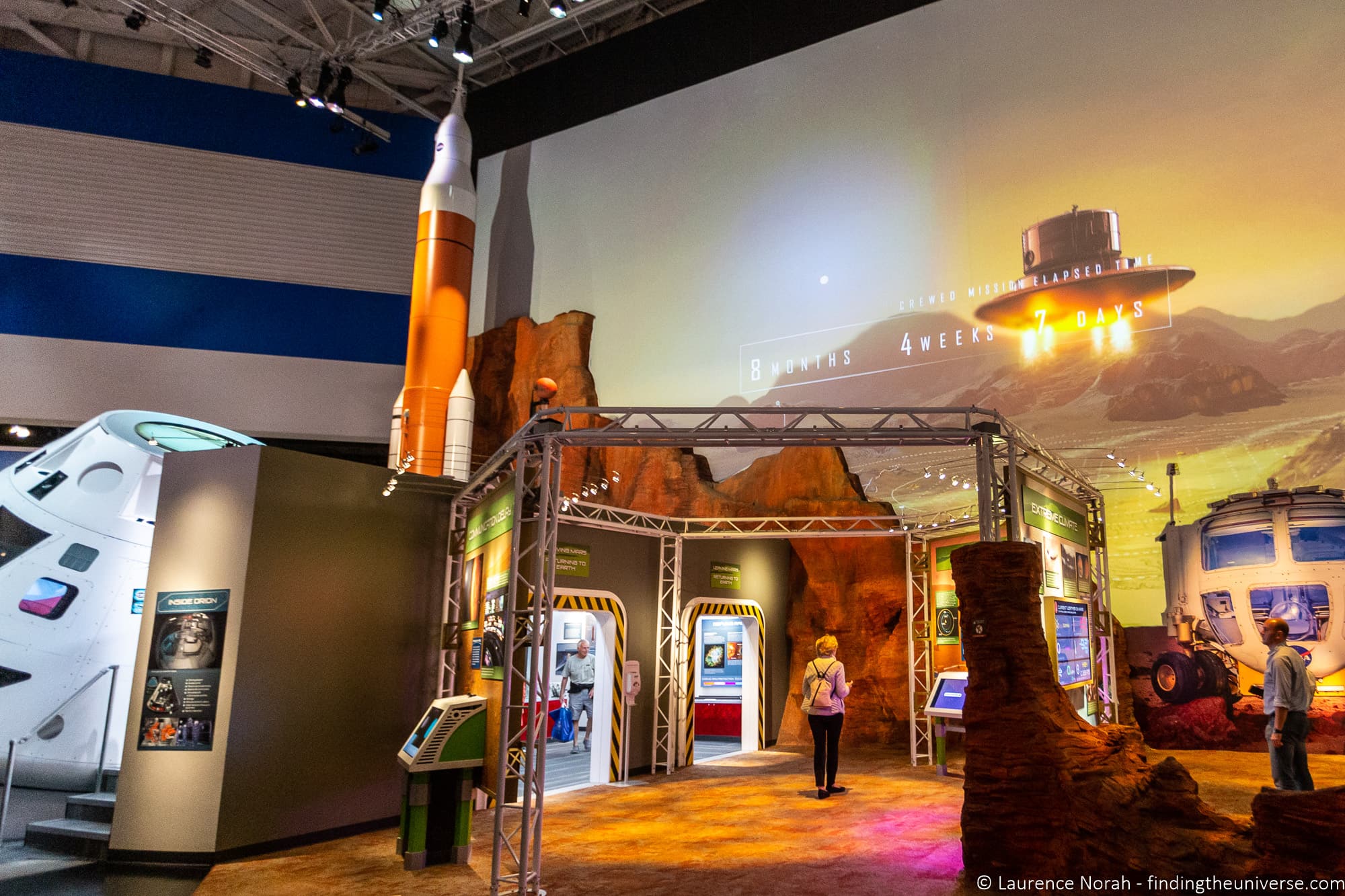
That’s just some of what is on offer at the Space Center Houston. As well as all the above, there are also regularly changing and updated temporary exhibits. So you definitely won’t run out of fun things to see and do!
How Long do you Need at Space Center Houston?
As you can see from all the things to do at Space Center Houston, you could easily spend a full day here.
We would suggest spending a minimum of 3 – 4 hours here, which will give you time to see some of the highlights and take a tram tour.
However, ideally you would plan to spend the full day here so as to have time to see and do everything without feeling rushed.
There’s a huge amount to see and do, especially when you consider the tram tour, films, interactive exhibits, and so on, and you should make the most of your ticket.
Do you Need to do the Tram Tour at Space Center Houston?
The tram tour at Space Center Houston is not mandatory and you can spend your time just exploring the museum.
However, if you have not visited the Space Center before and taken the tram tour, we would definitely recommend doing it as it is one of the highlights of the experience.
There are three options for the tram tour, depending on your interest. Two of these are included on your entry ticket whilst the third requires an additional fee payable when you book.
The tram tours are as follows:
- George W.S. Abbey Rocket Park Tour. Visits the Rocket Park where the Saturn V rocket can be found. Included on general admission, requires boarding pass (book on arrival with staff members at Guest Services Desk or with free app ).
- Astronaut Training Facility Tour. As well as Rocket Park, this tour also visits the Astronaut Training Facility to see where NASA astronauts train. Included on general admission, requires boarding pass (book on arrival with staff members at Guest Services Desk or with free app ).
- Historic Mission Control tour. This tour visit the actual mission control where NASA co-ordinated all the Apollo missions. It also includes Rocket Park. This tour has an additional fee and must be booked in advance when purchasing your general admission ticket. When you book you will choose a timeslot. If you are visiting with a CityPASS , you can pay $15 on site to upgrade to the Mission Control Tram Tour, subject to availability.
Of the tours, personally, I would pick the Mission Control tour as it’s such an iconic location. However, if you don’t want to pay the extra I would opt for the Astronaut Training Facility Tour as it includes Rocket Park.
Note that when we visited Mission Control it was being done up for the 50th anniversary of the Apollo landings, so this image isn’t representative of the experience you will have, however I did want to share it as I still though the consoles looked pretty cool – even in plastic wrap!
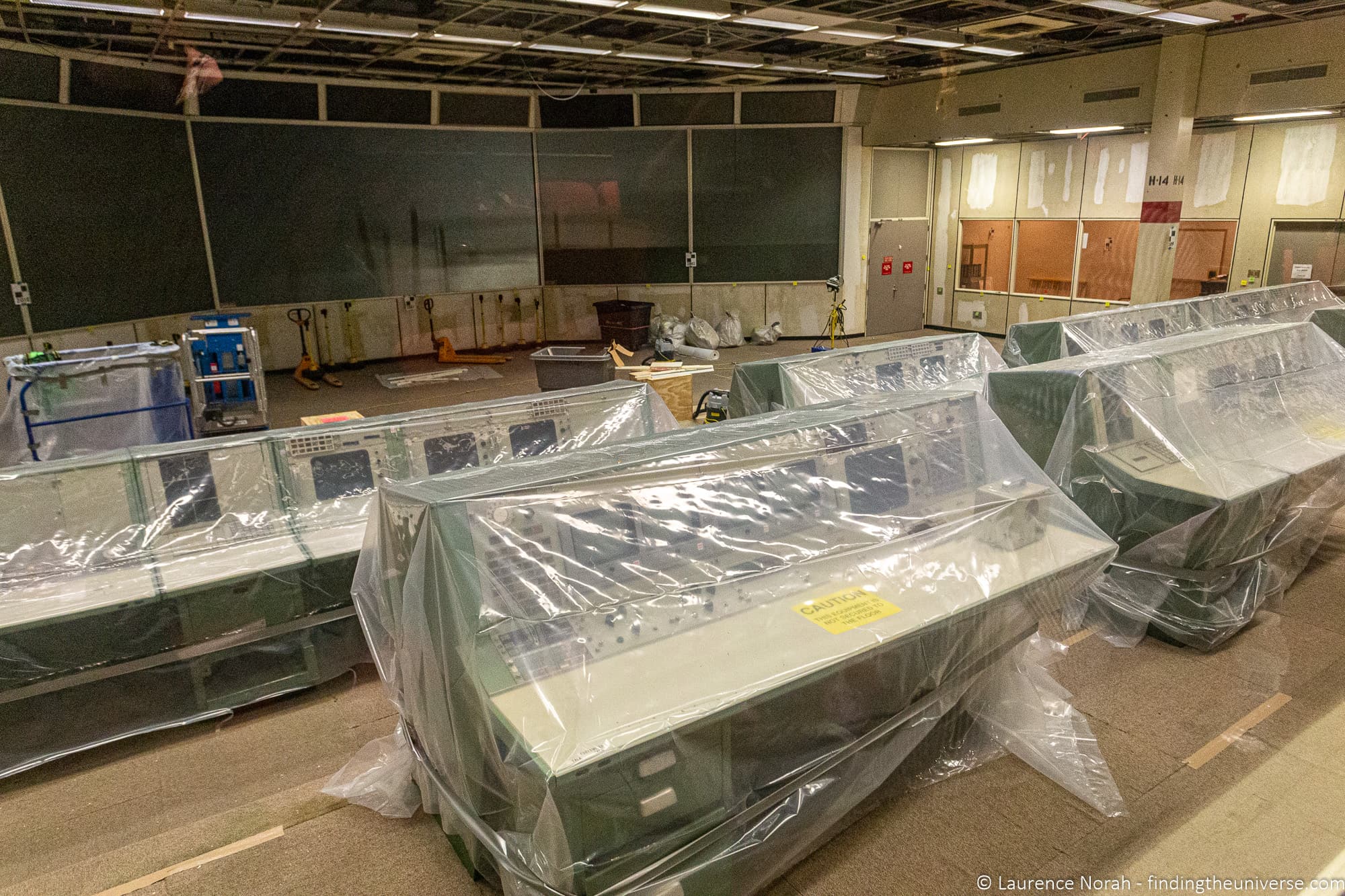
If you want, you can actually take multiple tram tours. However, as the tours last 90 minutes to 2 hours, this will use up a lot of the day.
Note also that the locations the trams visit can vary depending on operational schedules and other factors.
The Mission Control tour has pre-booked timed slots which you select when you book your admission ticket.
If you are not taking the Mission Control tram (or are visiting with a CityPASS and want to upgrade to the Mission Control tram), then we would suggest that you make booking your tram tour the first thing you do on arrival.
To take a tram tour, you need a timed boarding pass. You can either get this from the Guest Services desk at the entrance, or you can download the free Space Center Houston app and book that way.
Note that if you take the VIP tour, you have your own private minivan tour of the NASA Johnson Space Center.
Tram tours normally run from fifteen minutes after the Space Center opens, and run every 20 minutes, until 2 hours before closing. For example. if the Space Center closes at 5pm, the last tram will depart at 3pm.
We highly recommend checking times and booking your boarding pass for the tram as soon as you arrive, so you can be sure not to miss out.
Once you have booked the tram tour, you can explore the remainder of the museum at your own leisure until it is time to board.
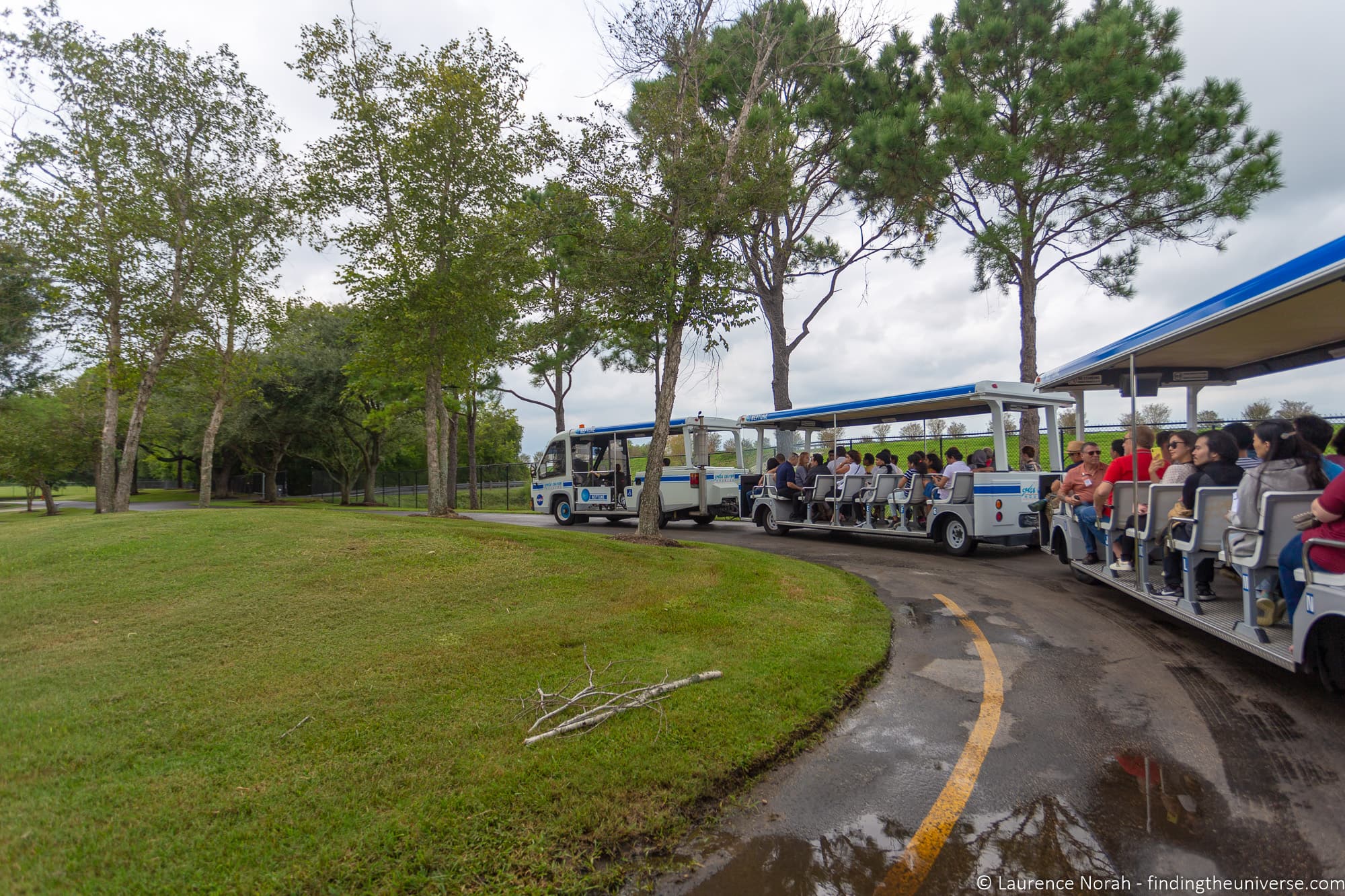
What are the Highlights of Space Center Houston?
If you are visiting the Space Center for a limited amount of time, you might be wondering what the best way to make the most of your time would be.
If it was me, my priority would be to take the tram tour over anything else. That’s because this is a really unique experience that you can’t get anywhere else.
The museum and all the exhibits are also excellent. However, if we had to pick some favourites for your visit, we’s suggest you visit:
- Independence Plaza, home to the world’s only shuttle replica, which is mounted on an actual shuttle carrying 747 aircraft
- The original Apollo 17 Command Module, which has flown to the moon. This is in the Starship Gallery
- The moon rock exhibit where you can actually touch a piece of moon rock. This is also in the Starship Gallery
- The gift shop, because it’s awesome!
Ideally though you will be able to see and do a lot more than the above.
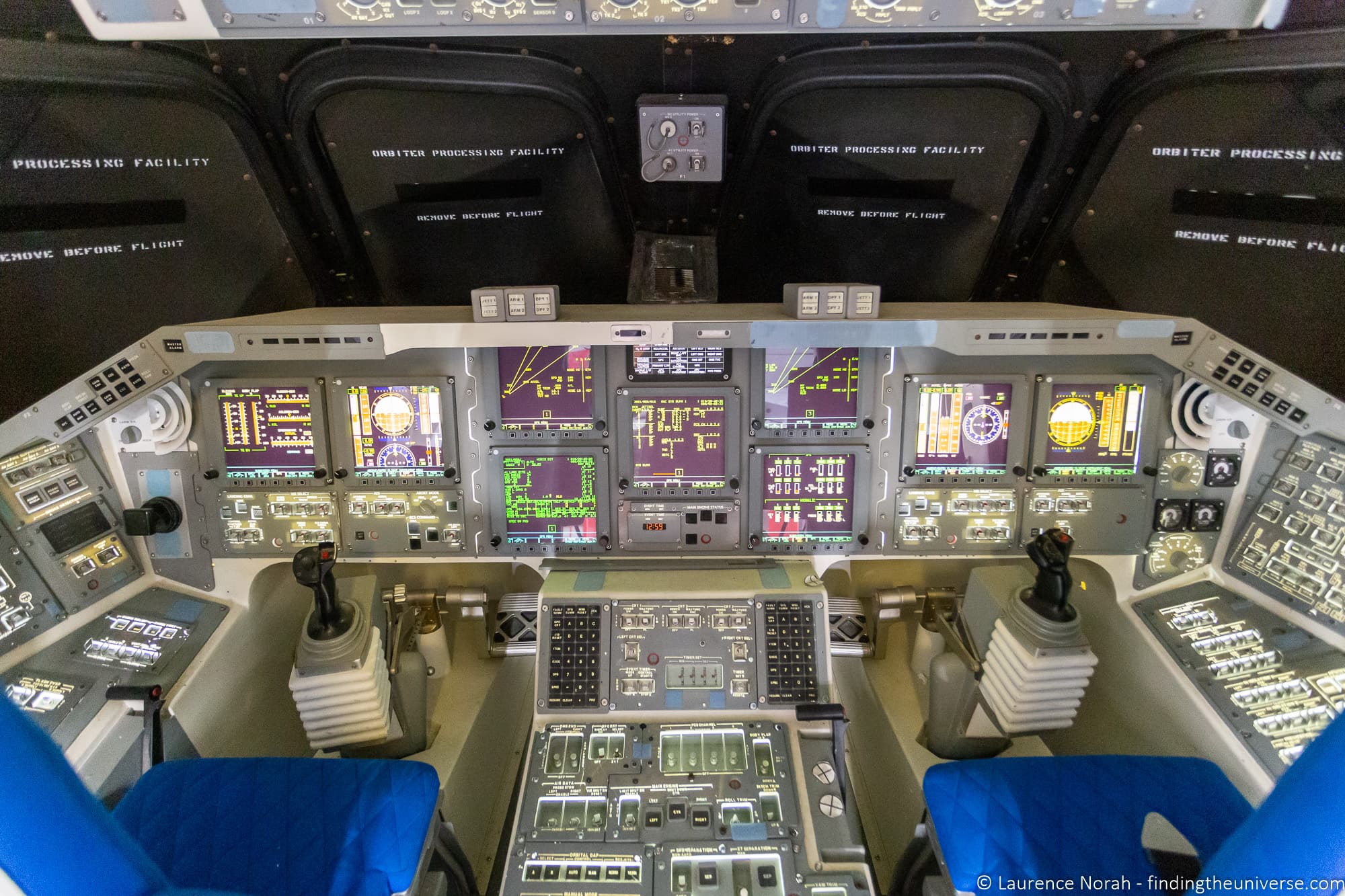
Is Food Available at Space Center Houston?
Yes, food is available for purchase at the Space Center. The dining area is called the Zero-G diner, and it has a range of food options from sandwiches and vegetarian options through to grilled food, burgers, and pizzas.
Food is not included on your entry ticket unless you have the lunch with an astronaut tour pre-booked, in which case you will have lunch served in a different location.
The Zero G diner does offer a 10% discount to Space Center Houston members, members of the U.S. military, and senior citizens. Be sure to present your I.D. before ordering to claim any discounts.
Is there an Audio Tour of Space Center Houston?
Space Center Houston offers the Space Center App for smartphones. This includes an audio tour, GPS maps of the location, AR experiences, and more.
This is available as a free download for both Android and Apple smartphones. You can find the correct link here .
We’d highly recommend getting this in advance of your visit, and remembering to bring a pair of headphones so you can take full advantage of it.
Up until 2018 there was a separate audio guide that was purchasable for a fee, however this is no longer offered as an option.
Is Space Center Houston Accessible?
Space Center Houston has made great efforts to provide a fully accessible experience across a range of accessibility needs.
In terms of general physical accessibility, all the exhibitions, theaters and tours are fully accessible to wheelchair users. There are also wheelchairs available on site on a first come first served basis.
Beyond physical accessibility, there are a number of other accessibility features, including events and programs for autism and sensory accessibility, deaf and hard of hearing accessibility and visual accessibility. Service animals, as defined by the ADA and Texas laws, are also permitted.
There’s an excellent page on the official Space Center website here , all about the various accessibility options and programmes available. We’d also recommend you reach our directly to the Space Center with any accessibility questions or needs you may have prior to your visit if you have any further queries.
Other Attractions near Space Center Houston
Space Center Houston is around 30 – 40 minutes drive south east of Houston, so you might be wondering if there are other attractions in the area.
The closest attraction which is popular with visitors to Houston, which is also covered on the Houston City PASS , is the Kemah Boardwalk . This is a large boardwalk which is home to a number of amusement rides, games, restaurants, and attractions. A great place for families.
You can either visit here yourself with a car, or you can take a tour from Houston that includes both the Space Center and Kemah Boardwalk like this .
For more inspiration on other things to do near the Space Center and in Houston in general, see our guide to things to do in Houston .
How Busy is Space Center Houston?
The Space Center is one of the most popular attractions in Houston, and as such it does get quite busy. The busiest times are on holidays, weekends, and during the summer.
If possible, we’d advise visiting outside of these times. During the busiest times, there can be long wait times for the tram tour in particular.
In addition, the Space Center is popular with school groups. These visit throughout the year, but the main months are March, April, and May.
These can definitely raise the volume level in the Space Center, and make it much busier, so bear this in mind if visiting during these months.
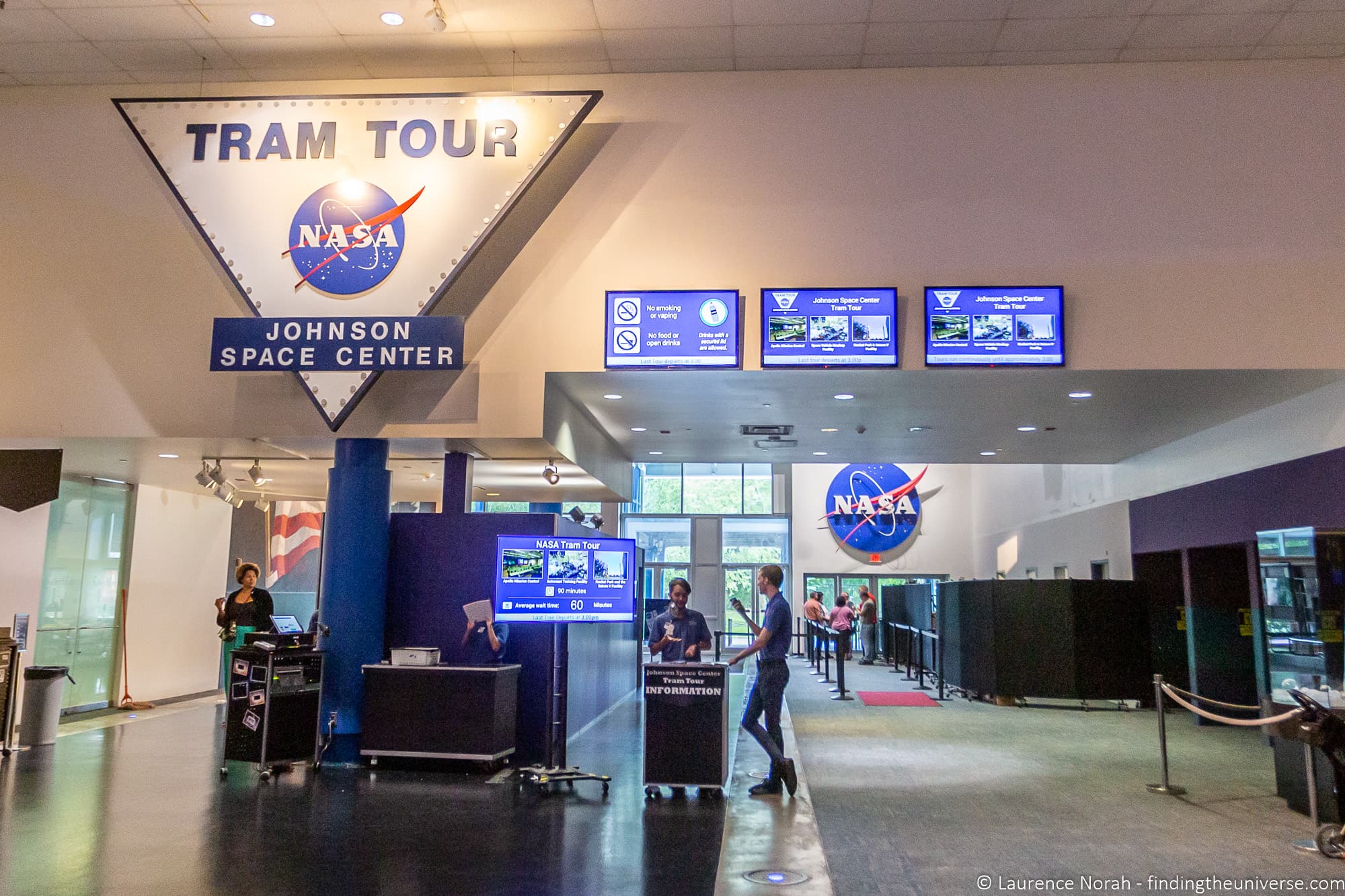
Opening Hours for Space Center Houston
Space Center Houston is open year round except on Thanksgiving and Christmas Day. Standard opening times are from 10am – 5pm, however during busy times they can open at 9am, and close at 6pm.
You can see a full day by day schedule of opening hours on the official website here . Note that opening hours are subject to change due to unforeseen circumstances, although this is rare.
Contact Information for Space Center Houston
If you want to contact the Space Center, you have a few options. First, most of your questions should be answered on their website, which you can see here .
If you still have questions about your visit, you can contact the Space Center by e-mail or phone.
Contact e-mail addresses are [email protected] or [email protected] . The phone number is +1 281-244-2100.
In my experience, e-mail was the fastest way to reach them for specific queries. The phone line has a number of automated response options with ticketing information and prices, but I wasn’t personally able to reach a human. E-mail responses on the other hand were fast and accurate.
Our Experience Visiting Space Center Houston
We visited Space Center Houston mid-week in late September, which turned out to be a great option as it was not too busy. The first thing we did was visit the tram tour info point, where we learnt the tram schedule for the day.
It was obvious when we visited the info point that there weren’t going to be major lines for the tram on the day of our visit.
This isn’t always the case of course, and at busy times the lines for the tram can be much longer – we were just lucky!
In addition, as we were lucky to be visiting on a quieter day, the tram was scheduled to visit all the highlights, so we didn’t have to pick a tram route.
We decided to come back to around 15 minutes in advance of a departure and spend some time exploring some of the exhibits. We visited the ISS display, the Starship Gallery, and the Mission to Mars exhibit.
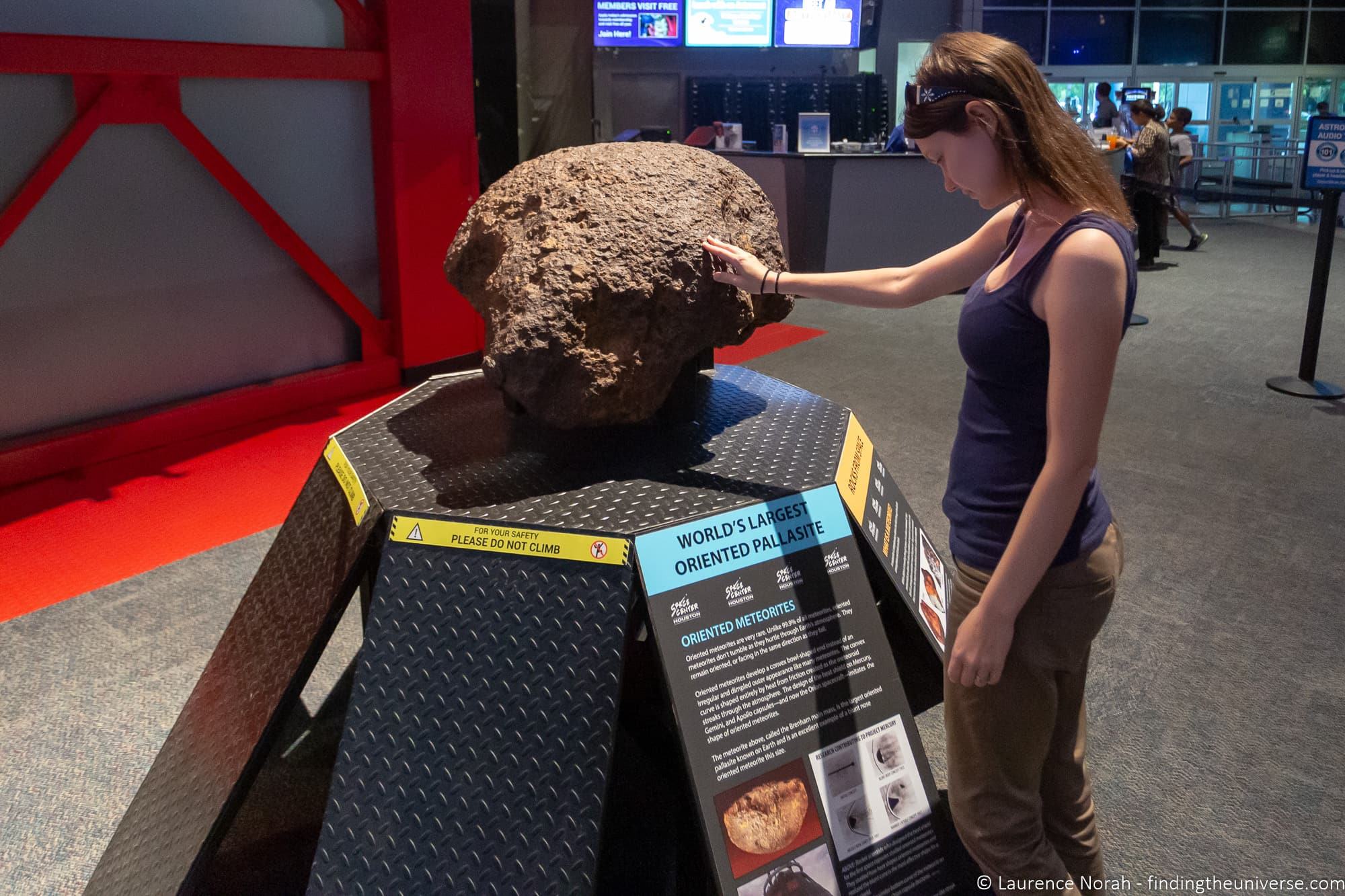
Then, it was time for the tram ride. As previously mentioned, there are usually different tram routes to choose from, but the day we visited it was less busy and so they were running a combined tour. This means we got to visit Mission Control, the astronaut training center, and the Rocket Park, which was pretty awesome.
The tram ride took just under two hours, and was the definite highlight of our experience. Seeing the historic Mission Control room, which was home to so many important moments in the space programme, was really something special. And this was despite much of it being covered in wrapping due to refurbishment!
We also enjoyed seeing the huge astronaut training center, but I have to say, the Rocket Park was something else. There’s nothing quite like being up close to a Saturn V rocket to give you an idea of the scale of these vehicles.
We were lucky enough to visit the US Space and Rocket Center whilst attending Space Camp in Huntsville Alabama , which is home to two more Saturn V rockets, and they were just as impressive!
Finally, after the tram tour, we visited the remainder of the main sights we wanted to see. The Independence Plaza was definitely a highlight – being able to get up inside one of the actual 747 shuttle carrier aircraft was a real experience, and seeing the scale of the shuttle against the 747 was amazing.
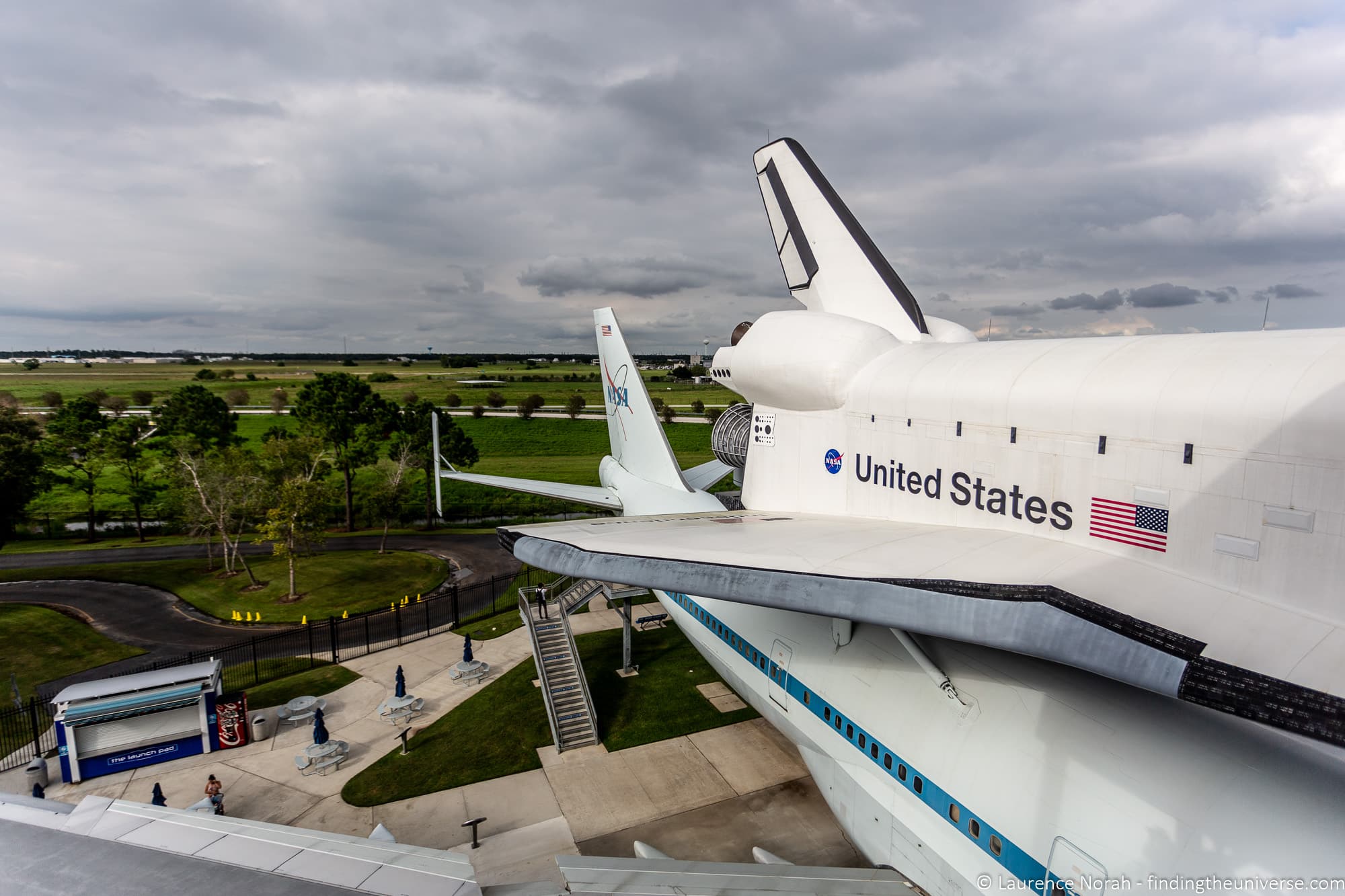
Tours of Space Center Houston
If you are visiting Houston and would prefer to take a tour that includes the Space Center, we’ve found the following two options for you to consider. These both include entry to the Space Center, return transport, plus some time exploring Houston itself.
- The first option is this 6 hour tour of Houston which also includes transport to and from Space Center Houston, as well as entry and a tour of the city
- The second option is this longer full day tour which includes a 1.5 hour tour of Houston, as well as time at the Space Centre and the Kemah Boardwalk.
Hopefully one of those tours might work for you!
Where to stay near Space Center Houston
If you plan on spending a full day at Space Center Houston, as we recommend that you do, then you might prefer to stay near the Space Center. This means you can be first in the door when it opens, and maximise your time.
We’ve found a number of accommodation options near the Space Center, at a variety of price points.
- Microtel Inn & Suites by Wyndham – This well rated budget 2* hotel is the closest option to the Space Center – it’s less than ten minutes walk across to the Space Center. There’s free on-site parking, work desks in the rooms, private bathrooms, and continental breakfast is included.
- Super 8 by Wyndham – Another well rated 2* property, this one is just a mile from Space Centre Houston. Rooms have private bathroom and coffee makers, there’s free parking, and continental breakfast is included.
- Best Western Webster – Another highly rated budget 2* property (there’s no shortage of choice in this area). Found 10 minutes drive from the Space Center. Rooms have refrigerators and microwaves, as well as work space. Parking is free and breakfast is also included.
- Springhill Suites Houston – A well rated 3* hotel around 6 minutes drive from the Space Center. Rooms are all suites with separate living areas as well as a refrigerator and microwave. Breakfast and parking are included, and laundry / gym services are offered.
- TownePlace Suites by Marriott – Found 2 miles from the Space Center, this well-rated 3* property offers self-catering suites which include a microwave, oven, stove and refrigerator. There’s also a gym, pool, and jacuzzi. Breakfast and parking are also available on site.
- Holiday Inn Kemah – If you want a hotel near the Kemah Boardwalk, this well rated 3* option would be our pick. It’s within walking distance from the boardwalk, and rooms feature microwaves, fridges, and tea/coffee making facilities. Free parking is included, and breakfast is optional.
Between these options we hope you will find something to suit your needs and budget.
Further Reading
Well, that’s it for our guide to visiting the Space Center in Houston, Texas. Before you go, we wanted to share some other content that we think you’ll find useful in planning your trip.
- There’s lots more to do in Houston beyond the Space Center. See our guide to things to do in Houston for some inspiration.
- If you’re visiting a number of cities in Texas, we have guides to a number of those as well! We have a guide to things to do in Austin , things to do in San Antonio , as well as a guide to things to do in Dallas
- If you do visit San Antonio, we also have a detailed guide to visiting the Alamo , and the San Antonio River Walk , which will help you plan your time visiting these two popular San Antonio attractions
- Love space? So do we, and the Space Center in Houston is far from the first space attraction we’ve written about! We have a guide to visiting the U.S. Space and Rocket Center , a guide to attending Space Camp , a guide to getting into space as a tourist , and a guide to New Mexico’s Space Trail , for more space related fun!
- We also have lots of resources to help you plan a trip to the USA. See our guides to how much it costs to travel in the USA and driving in the USA as starting points.
- If you want some road trip inspiration, see our itineraries for a USA Deep South road trip , California Road Trip , Route 66 Road Trip and Pacific Coast Highway Road Trip
- We’ve visited a lot of other cities in the USA! See our guides to Things to do in Huntsville , Things to do in Savannah , Things to do in Charleston , Things to do in Albuquerque , Visiting New Orleans During Mardi Gras , Things to do in Cambria and Things to do in Santa Fe to get started!
We hope you’ve found our guide to the Space Center in Houston useful! As always, we’re happy to hear your feedback and answer your questions. Just use the comments section below, and we’ll get back to you as soon as we can.
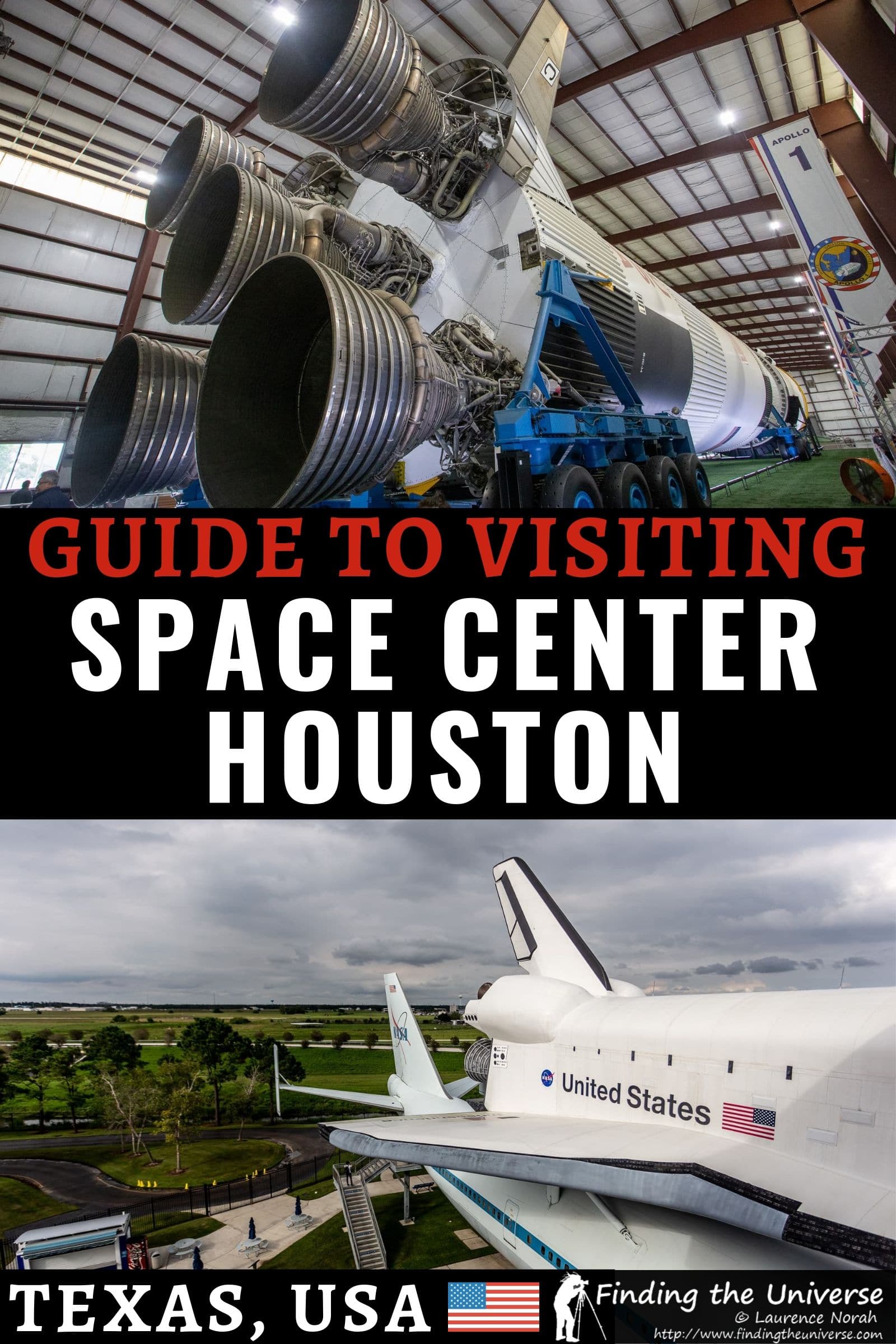
Enjoyed this post? Why not share it!
There are 8 comments on this post
Please scroll to the end to leave a comment
Maryam Boone says
25th February 2023 at 2:34 am
Your information was EXCELLENT! I’ve lived in Houston for 2 years now but haven’t had a chance to visit the Space Center -even though I’ve driven past it going to Galveston several times. My daughter and son-in-law are coming to visit and we are going this weekend. I had viewed the Space Center’s website last month but still had a few questions. Your information answered all of my questions and was much, much better than the Space Center’s site! Thank you so much for giving such detailed and informative information. If this is the type of information you provide about other attractions you visit, then these attractions should pay you for the excellent information you provide!
Laurence Norah says
25th February 2023 at 6:07 am
Hey Maryam,
Thanks so much for taking the time to leave a comment and let me know! It’s much appreciated 🙂 I hope you guys have an awesome visit to the Space Center! I’d love to hear how it goes, and if you notice anything there that isn’t quite right in my guide, feel free to let me know 🙂
Philip Baker says
12th March 2021 at 10:48 am
Hi, thinking of having a holiday in Texas march 22 if they let us fly from UK and was looking on Google maps for places to visit, two days later your site popped up on my phone, must say best travel site I have seen. Phil
12th March 2021 at 10:59 am
Thanks so much Phil, that’s very kind of you to take the time to let us know! I hope you are able to take advantage of our tips on a trip to Texas, and if you have any questions, just let me know 🙂
Kurt Peterson says
27th October 2019 at 1:24 am
Laurence and Jessica, Thank you for the great piece on The Space Center in Houston. My wife and I are looking forward to our visit in mid November. We have been privileged to have had the opportunity to visit both The Kennedy Space Center and the NASA facility in Huntsville. We are throughly excited about seeing the ‘real’ mission control room. Seeing the Saturn 5 rocket is always pretty amazing. Thanks again, Kurt and Veronica Peterson
27th October 2019 at 1:57 pm
Our pleasure Kurt! Have an amazing time, and do let us know how you enjoy it compared to the other locations you’ve visited 😀
Sesh Komanduri says
13th August 2019 at 11:43 am
Excellent write-up, Jessica and Laurence. I finally found the guide I was looking for!! One quick question. Is it easy to get a Uber/lyft on the way back from the Space Center to downtown? I want to use that option rather than a standard tour so that I have maximum time at the Center and return as per my convenience. But dont want to get stranded there without transport!!
13th August 2019 at 12:05 pm
So we’ve not personally done this ride with Uber or Lyft, but looking at what other travellers have said and checking the Uber app, it does look like it shouldn’t be a problem 🙂
Have a great time!
Leave a Reply Cancel reply
Your email address will not be published. Required fields are marked *
Let me know when there's a reply to my comment (just replies to your comment, no other e-mails, we promise!)
Subscribe to our monthly Newsletter where we share our latest travel news and tips. This also makes you eligible to enter our monthly giveaways!
We only ask for your e-mail so we can verify you are human and if requested notify you of a reply. To do this, we store your data as outlined in our privacy policy . Your e-mail will not be published or used for any other reason other than those outlined above.

Buy Tickets
- Register For Camp
U.S. Space & Rocket Center
Open daily, 9 a.m. - 5 p.m.
Closed Thanksgiving Day, Christmas Eve, Christmas Day, and New Year's Day
Have a question about the U.S. Space & Rocket Center museum, exhibits, or simulators? Call (256)721-7114 or click here to contact us .
- INTUITIVE® Planetarium
- Museum Group Visits
- Host an Event
General Admission Tickets
General admission to the u.s. space & rocket center includes access to the saturn v hall, moon crater, military park, rocket park, shuttle park, sparklab, iss: science on orbit, and available featured exhibit(s), simulators, and tours..
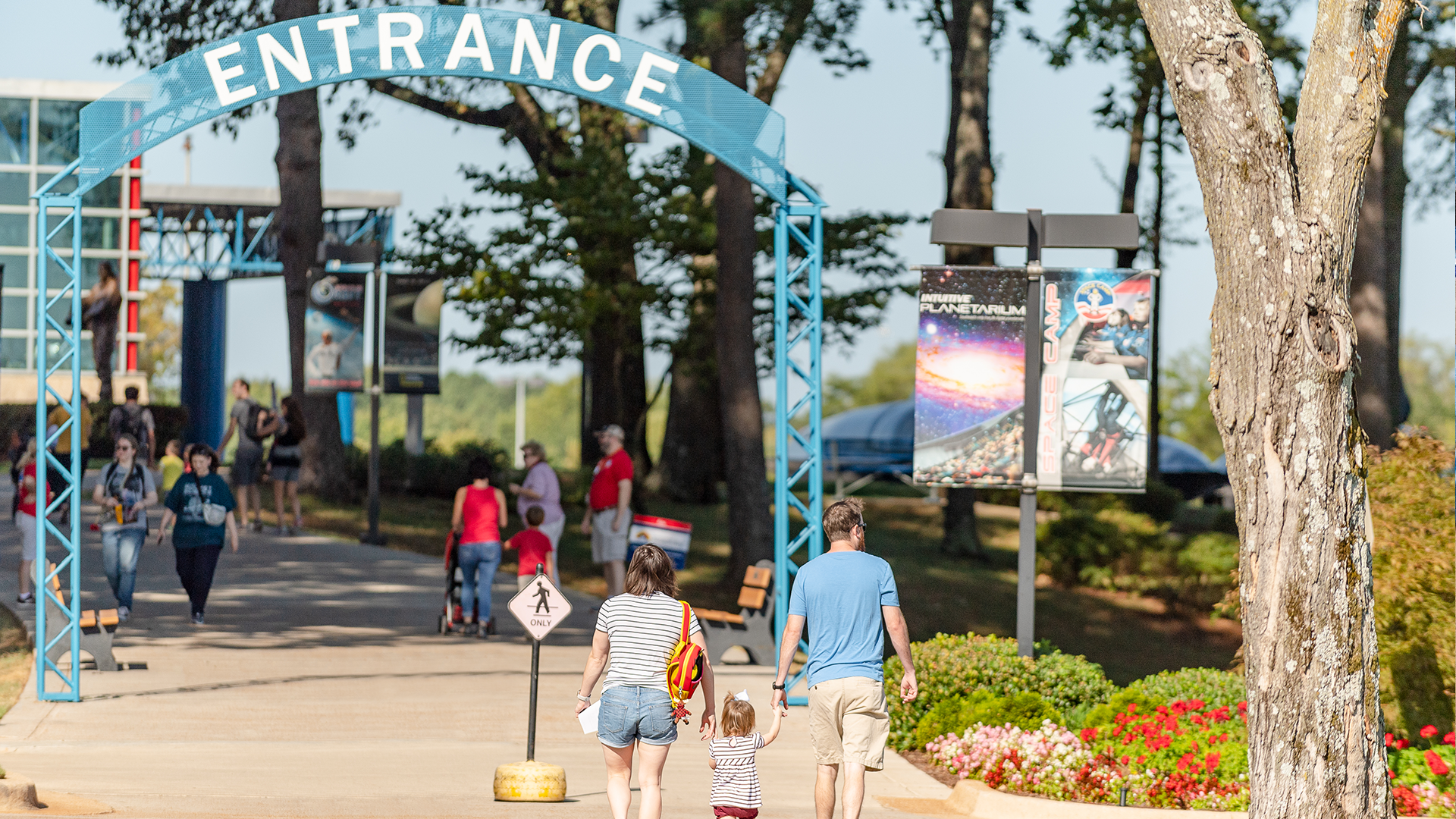
Adult & Senior (Ages 13+): $30
Child (ages 5-12): $20, members: free, children 4 & under: free.
The U.S. Space & Rocket Center is unable to accept personal checks and traveler's checks as form of payment.
All ticket sales are final and are not refundable or transferable. No refunds will be given due to inclement weather or malfunctioning simulations.
Discounted tickets must be purchased on-site at our ticket desk to verify eligibility. Discounts may not be used in combination with any other discounts, promotions or special events Badge holder/cardholder must be present to qualify for discounts
ASTC Affiliate Reciprocal Membership
Free general admission for member cardholder (up to 1 adult and 2 children). Learn More
Seniors (65+)
$3 off shows in the INTUITIVE® Planetarium with general admission purchase.
NASA Contractors
Free admission and $3 off shows in the INTUITIVE ® Planetarium
NASA Civil Servants and Retirees
(includes spouse and dependents) Free general admission and $3 off shows in the INTUITIVE ® Planetarium.
TVA Employees and Retirees
Free general admission for badge holder. Spouse and dependents receive $20 general admission price.
(Active, Veteran, Retiree) $3 off daytime movies and shows in the INTUITIVE ® Planetarium with general admission purchase.
$3 off daytime movies and shows in the INTUITIVE ® Planetarium with general admission purchase.
Smithsonian Affiliate Reciprocal Membership
Free general admission for member card holder (up to 2 people).
Museums for All
(w/ Valid EBT or SNAP card) $3 general admission (up to 4 visitors)
- People who live in the following counties: Madison, Morgan, Marshall, Jackson, and Limestone Counties presenting a membership to another ASTC museum, we will not accept that membership as admission into the U.S. Space & Rocket Center.
The U.S. Space & Rocket Center offers free parking, RV and bus parking for guests
For the safety of our staff and guests, outdoor simulators are operational when temperatures are between 45 - 101 degrees Fahrenheit (Moon Shot between 50-101 degrees Fahrenheit) and when weather permits.
Guest Services
The U.S. Space & Rocket Center Guest Services and Information Desk is located at the ticket desk in the main museum. We are dedicated to making your visit to the Center a terrific experience, and we offer the following services:
- Simply leave your driver’s license or picture identification with the ticket desk and check out a wheelchair or stroller for the day.
- $25.00 Rental
- Available at the ticket desk
- Weight Limit: 450 lbs.
- Renew a membership, update information on your account, or check in to the museum for the day. If you aren’t a member yet, this is where you’ll become part of our community!
- Click here to learn more about Membership opportunities.
- If you have a group reservation, please check with our Daily Group Coordinator to confirm your check-in location! Most groups check in at the Davidson Center for Space Exploration, however this is subject to change depending on your arrival time.
- Check in here with employee passes, comp tickets, or if your name is on the guest register.
- Houston Tourism
- Houston Vacation Rentals
- Houston Photos
- Houston Map
- All Houston Hotels
- Houston Hotel Deals
- Last Minute Hotels in Houston
- Houston Motels
- Houston Hostels
- Houston Campgrounds
- Houston Business Hotels
- Houston Family Hotels
- Houston Green Hotels
- Houston Spa Resorts
- Romantic Hotels in Houston
- Houston Luxury Hotels
- Houston Resorts
- Houston Beach Hotels
- Houston Casinos
- 5-stars Hotels in Houston
- 4-stars Hotels in Houston
- 3-stars Hotels in Houston
- Homewood Suites by Hilton in Houston
- Crowne Plaza Hotels in Houston
- Hyatt Place Hotels in Houston
- Scottish Inns in Houston
- Westin (Marriott Bonvoy) Hotels in Houston
- Home2 Suites by Hilton in Houston
- Days Inns in Houston
- JW Marriott (Marriott Bonvoy) Hotels in Houston
- Four Points (Marriott Bonvoy) Hotels in Houston
- Rodeway Inns in Houston
- La Quinta Inns & Suites in Houston
- Hampton by Hilton Hotels in Houston
- Houston Hotels with Pools
- Pet Friendly Hotels in Houston
- Houston Hotels with Free Parking
- Downtown Houston Hotels
- Great Uptown Hotels
- Westchase Hotels
- Medical Center Hotels
- The Museum District Hotels
- University Place Hotels
- Afton Oaks/ River Oaks Hotels
- Greenway/ Upper Kirby Hotels
- Washington Ave./ Memorial Park Hotels
- Clear Lake Hotels
- Honeymoon Hotels in Houston
- Houston Hotels with Balconies
- Houston Hotels with Smoking Rooms
- Hotels with Shuttle in Houston
- Suite Hotels in Houston
- Houston Hotels with Hot Tubs
- Romantic Boutique Hotels in Houston
- Boutique Spa Hotels in Houston
- Historic Hotels in Houston
- All Inclusive Hotels in Houston
- Things to Do
- Restaurants
- Vacation Rentals
- Travel Stories
- Rental Cars
- Add a Place
- Travel Forum
- Travelers' Choice
- Help Center
Hi, What is the difference between the red tram...
- United States
- Texas (TX)
- Texas Gulf Coast
- Houston
- Things to Do in Houston
- Space Center Houston
Space Center Houston Questions & Answers
Hi, What is the difference between the red tram tour and the blue tram tour? Which one would be more enjoyable for a 10yr old child? How to do both the tram tours on the same day? tnx.
Each tram tour visits different locations at NASA Johnson Space Center as other users have stated. Tour details are listed on monitors around the tram queue or you can ask a crew member the day of your visit.
Two different tours each approx. 90minutes long.
Red Tour - Saturn V Rocket & park + Astronaut training facility.
Blue Tour - Saturn V Rocket & park + Mission Control facility.
Both the tours drop you off at the rocket park at the end. You can spend your own time and then catch a different tram back to the space center.
You may even be able to see people working in the mission control facility.
So it depends what interests you.
It is great to visit the old and new mission control centres. The old is the one from the Apollo missions and the new you see the live support of the space station. Real time.
The training facility is a few minutes drive away and this is where they have a replica of the space station in a large water tank or swimming pool. This is where the astronauts practice tasks and you can watch them performing the jobs.

Sorry, Trams
Each tram goes to a different place at the center. As long as you get there early, you can do both teams.

Red team tour covers Saturn V rocket park and astronaut training facility (ISS - international space station)
Blue team tour covers Saturn V rocket park and mission control (either old one for Apollo program or new one for ISS)
One tram tour is approximate 100 minute
Red tram is mostly like fit for teenages
If you have enough time in NASA, better to try both tram tours
Hopefully, this will help you and your kids.

The answer given by Houston Tours is good and I can't add to it.
Browse nearby
Ask a question.
Get quick answers from Space Center Houston staff and past visitors.

- Park Overview Explore Missions Zones
- Heroes and Legends Space Pioneers
- Behind the Gates Kennedy Space Center Bus Tour
- Race to the Moon Apollo Moon Landing
- Shuttle: A Ship Like No Other NASA's Space Shuttle Program
- NASA Now + Next Preparing for Journey to Mars
All Attractions
- Plan Your Visit
- Hours Of Operation
- Hotel Packages
- Travel Information
- Events Overview
- Event Calendar
- See A Launch
- Groups Overview Plan Events and Tours
- Youth Groups Programs and Field Trips
- Scouts Adventures for Scout Troops
- Private Events Events and Custom Tours
- International Programs and Custom Tours
- Camp KSC Day Camp for Students
- Educators Resources for Teachers
- Programs Educational Programs at KSC
- Accessibility Information

U.S. Astronaut Hall of Fame ®
All Systems Are Go!
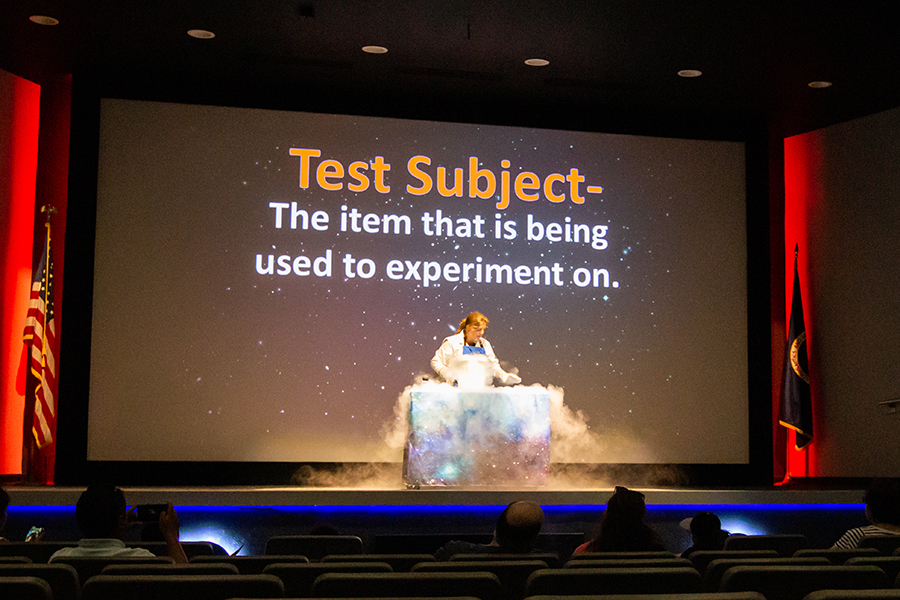
It's a Matter of Fact Show
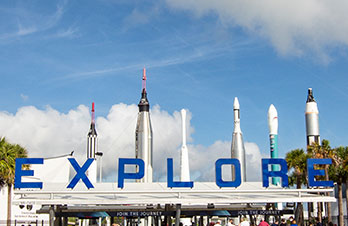
Rocket Garden
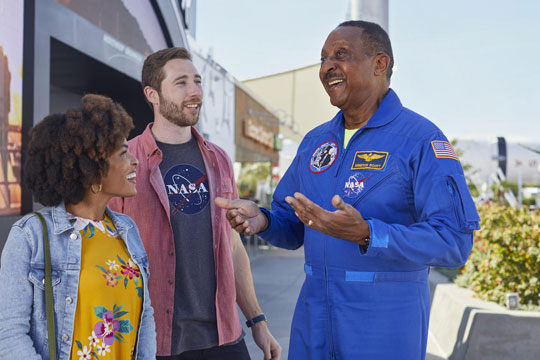
Astronaut Encounter
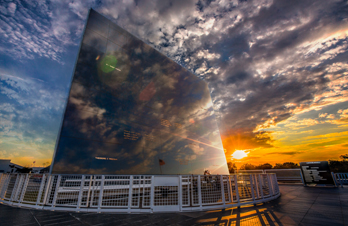
Space Mirror Memorial
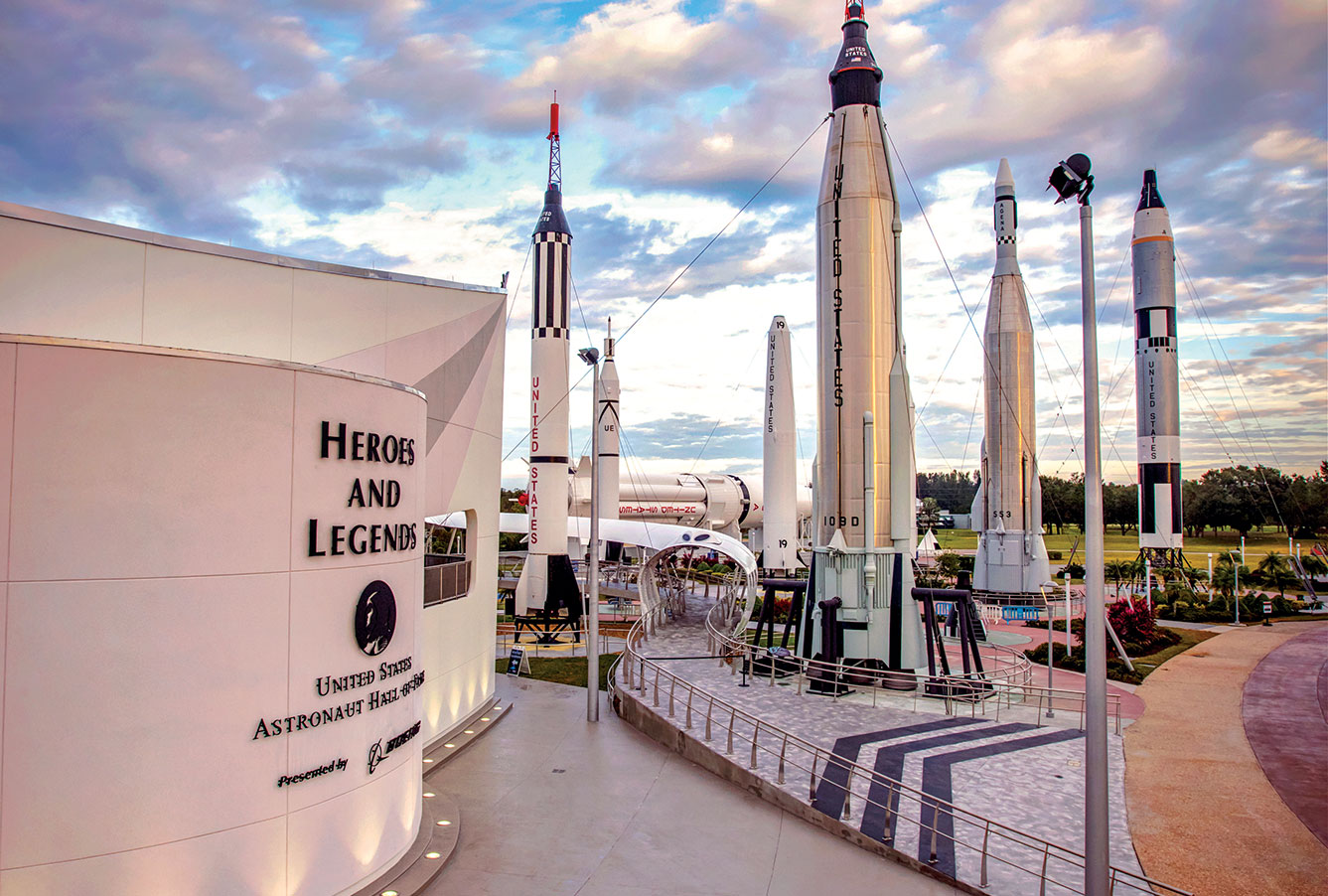
Heroes & Legends
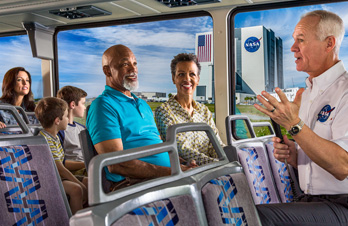
Kennedy Space Center Bus Tour
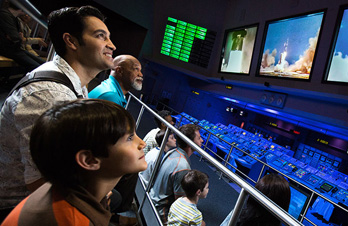
Apollo 8 and the Firing Room
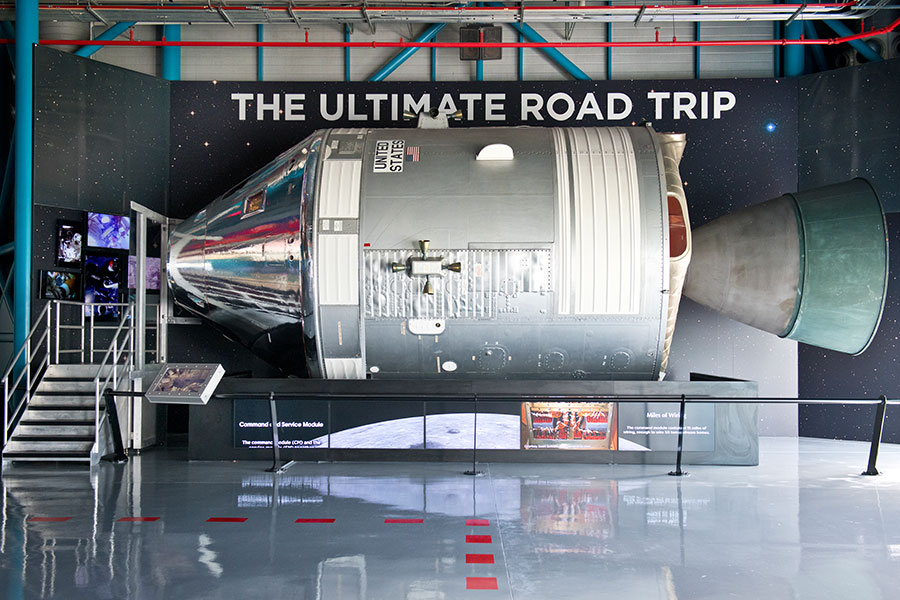
Path to the Moon
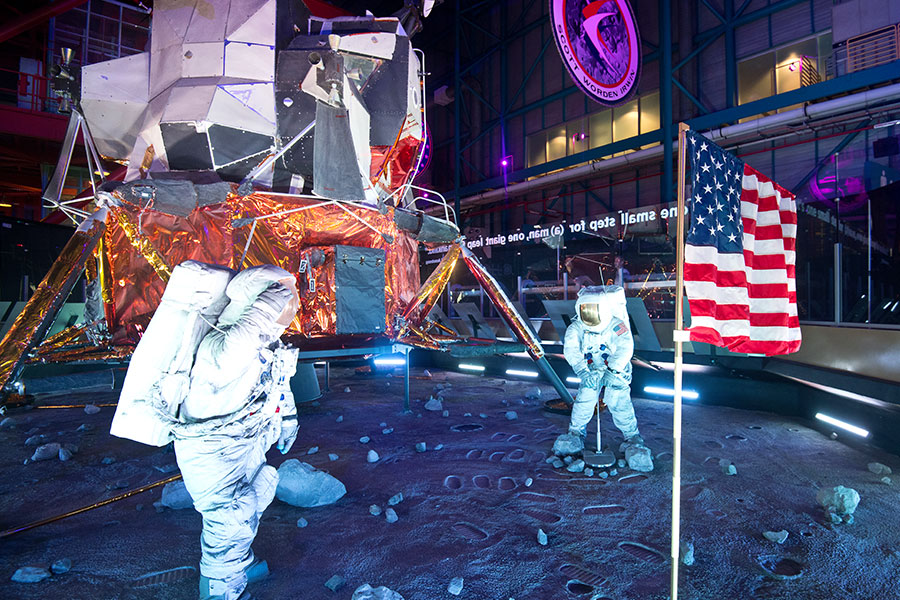
Exploring the Moon
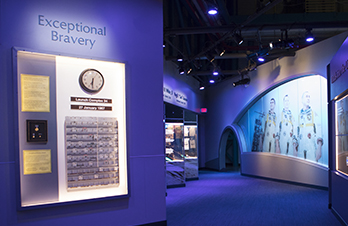
Ad Astra Per Aspera
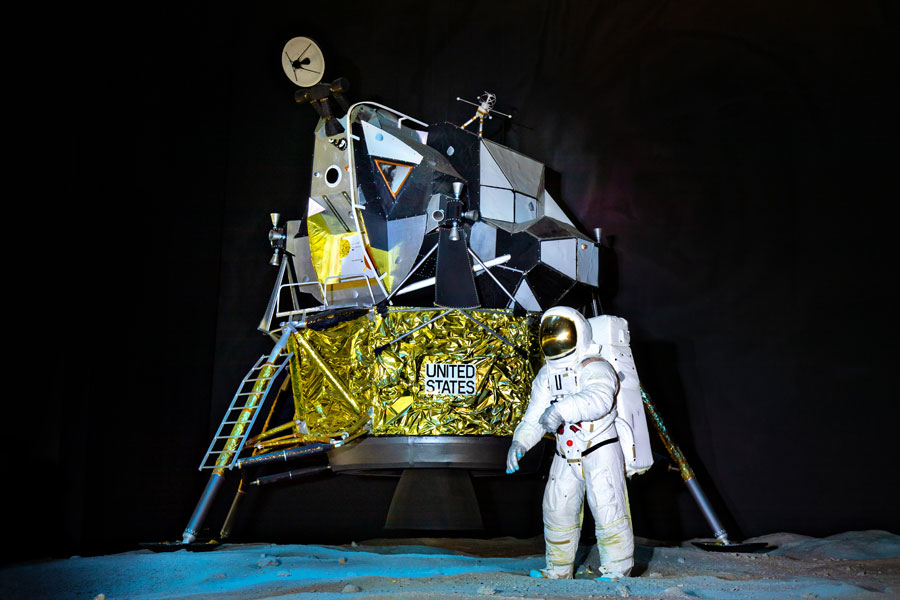
Lunar Theater
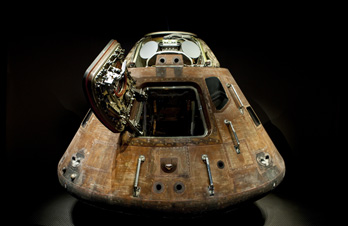
Apollo Treasures Gallery
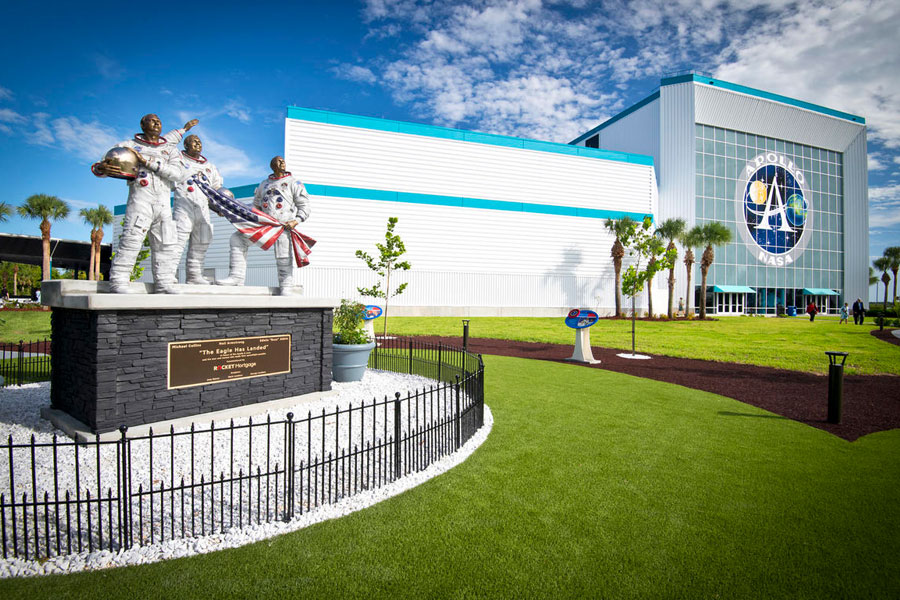
Moon Tree Garden
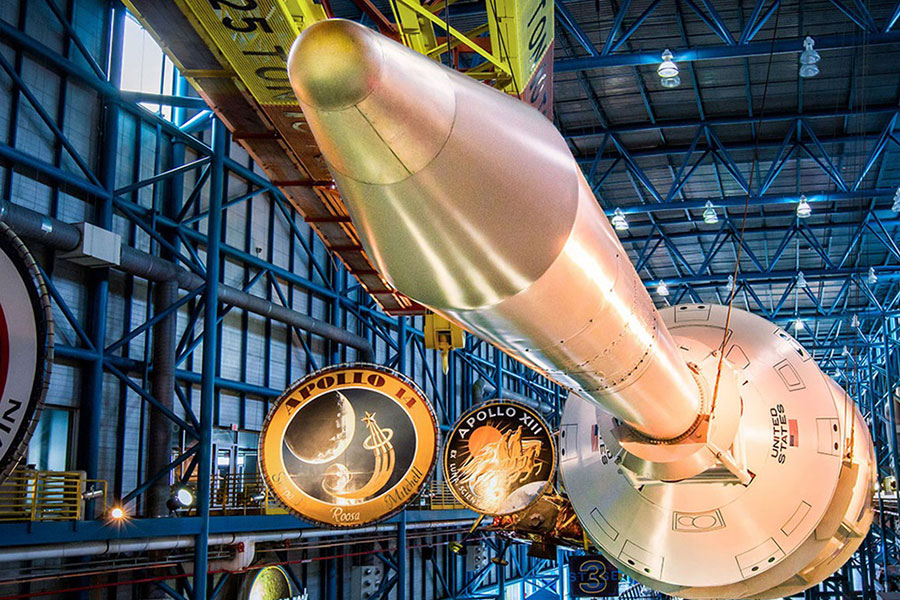
SATURN V ROCKET
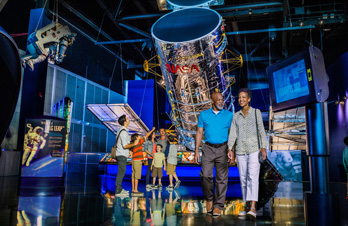
Hubble Space Telescope Theater
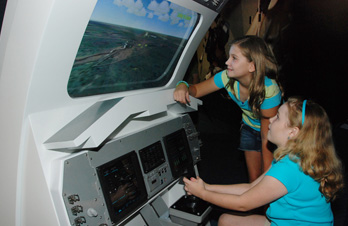
Astronaut Training Simulators
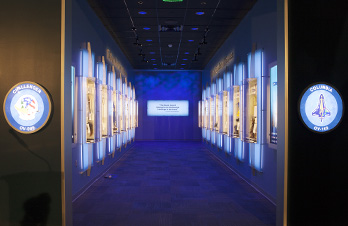
Forever Remembered
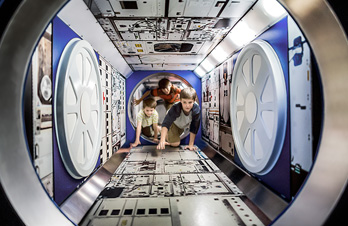
ISS Triumph of Technology
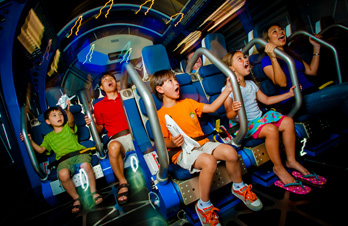
Shuttle Launch Experience®
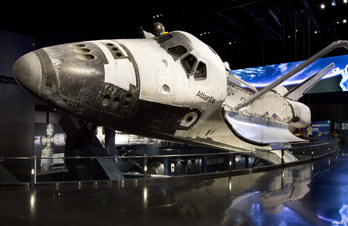
Space Shuttle Atlantis®
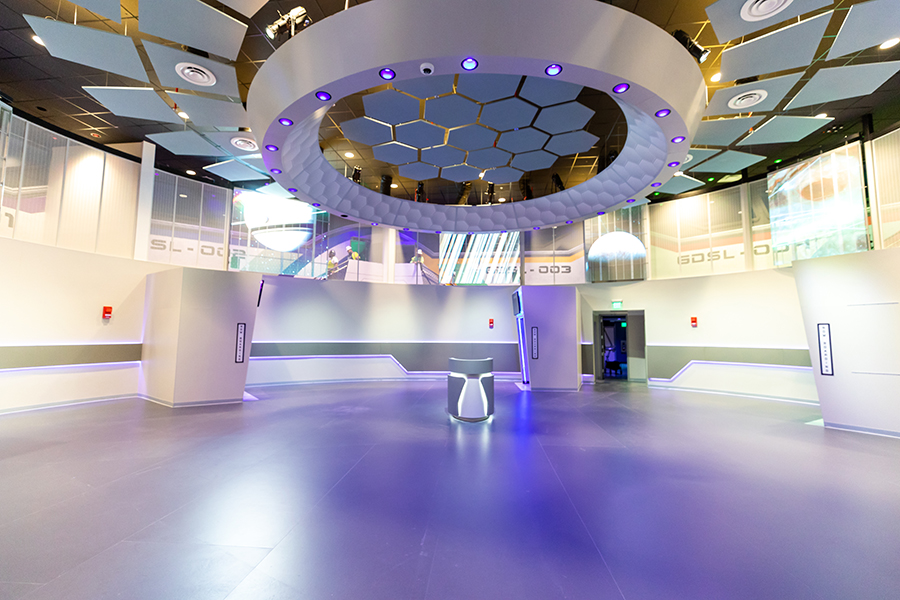
Spaceport KSC
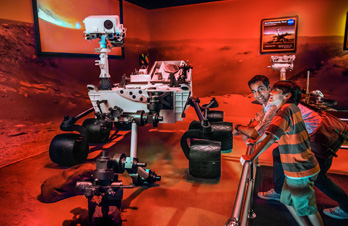

Journey To Mars | Launched by United Launch Alliance
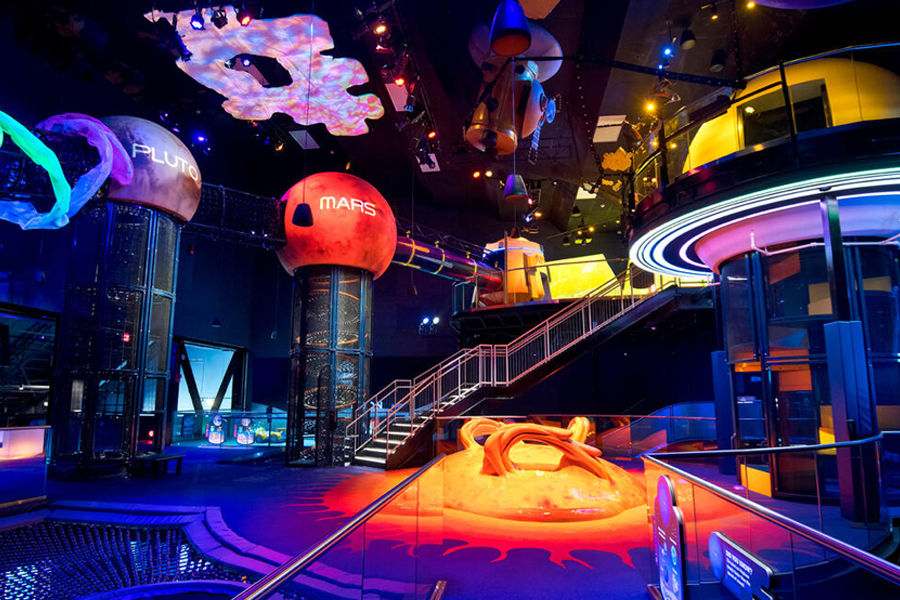
Planet Play
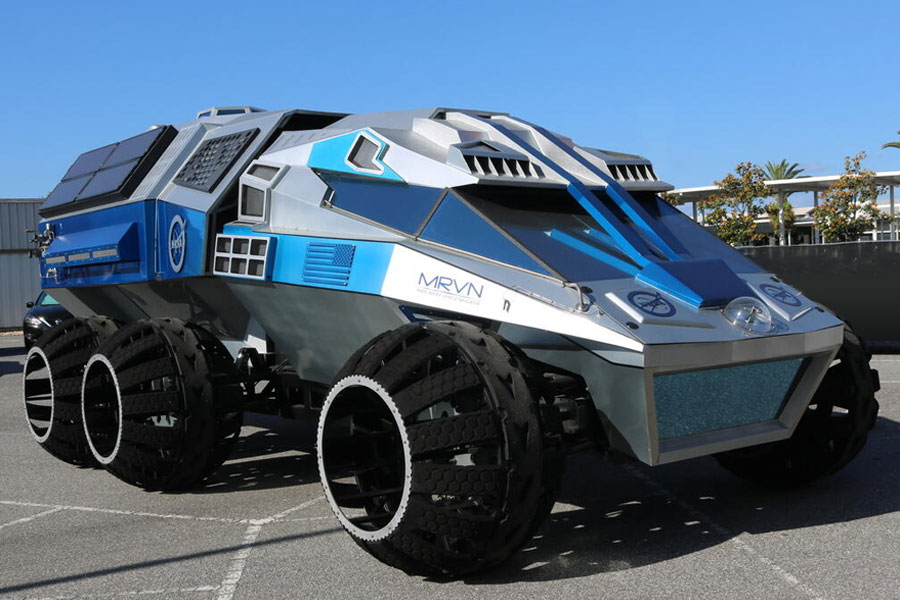
Mars Rover Vehicle Navigator®
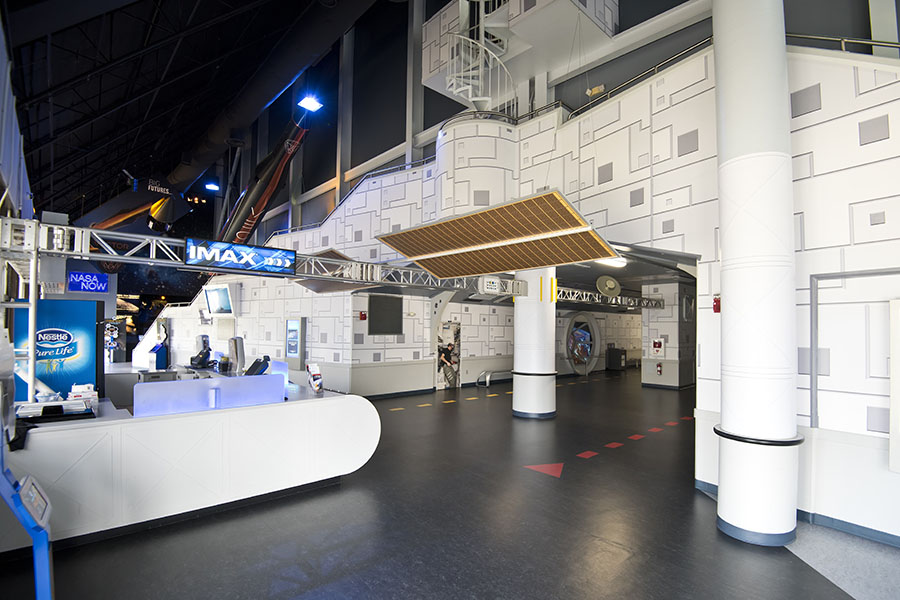
IMAX Theater
It’s the next best thing to being in space, minus the microgravity, and you can eat popcorn! Space movies are available daily in the IMAX Building and are included with admission.
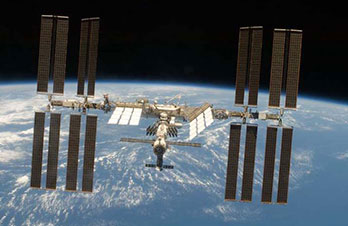
Mission Status Briefing
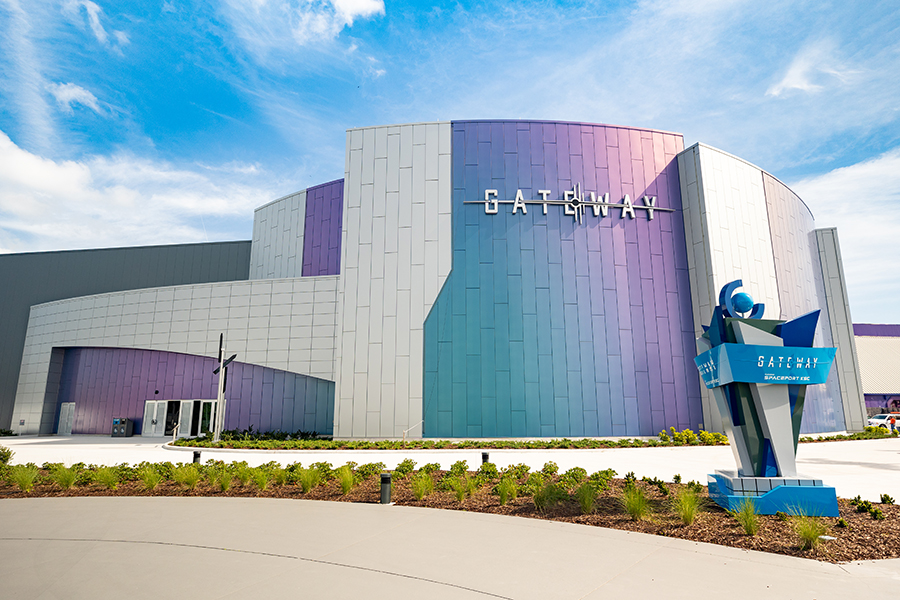
Gateway: The Deep Space Launch Complex®
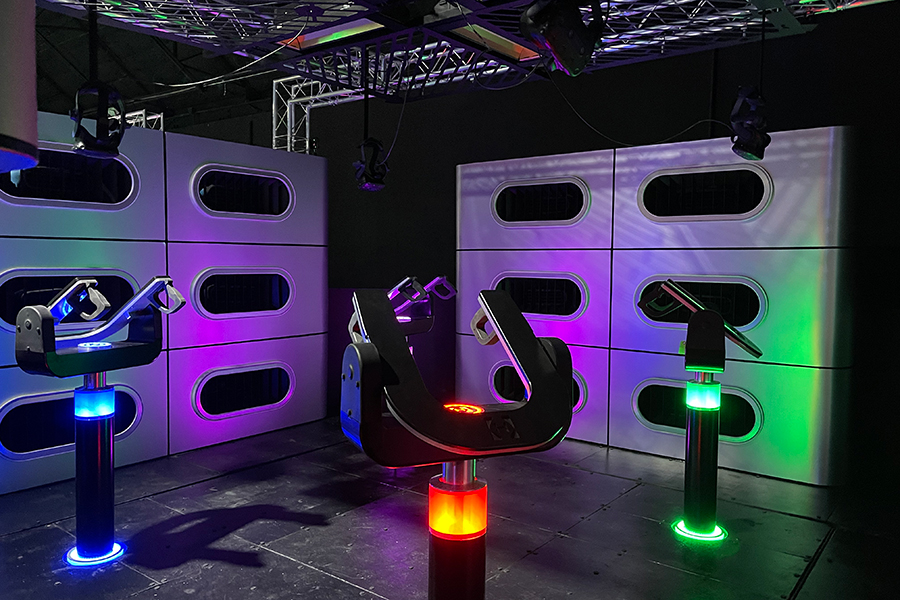
HYPERDECK VR
HYPERDECK is an all-new immersive, virtual reality experience . Up to 8 players enter into a dynamic virtual world featuring a full-motion floor and multi-sensory effects like strong winds, heat, and earth-rattling movements.
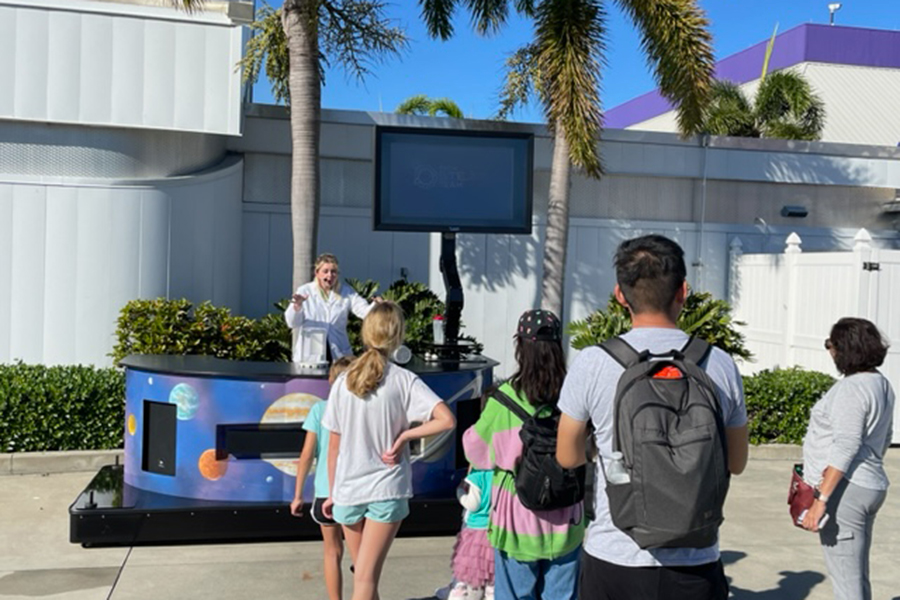
S.T.E.A.M. Interactive Carts
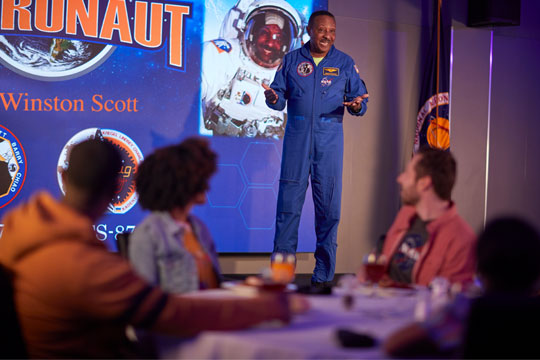
Chat With An Astronaut
Kennedy Space Center Explore Tour
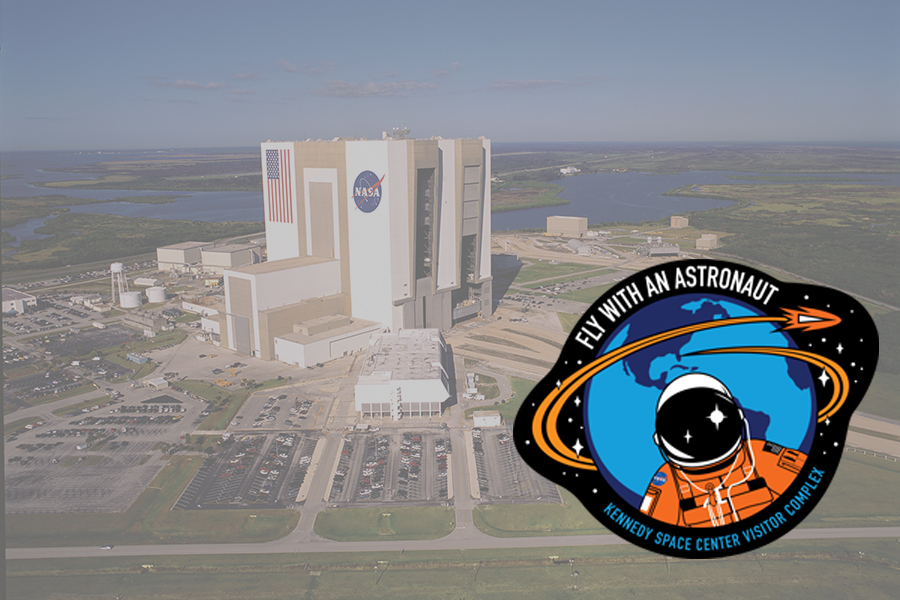
Fly With An Astronaut
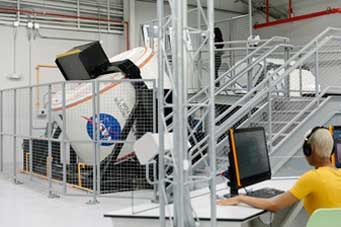
Astronaut Training Experience
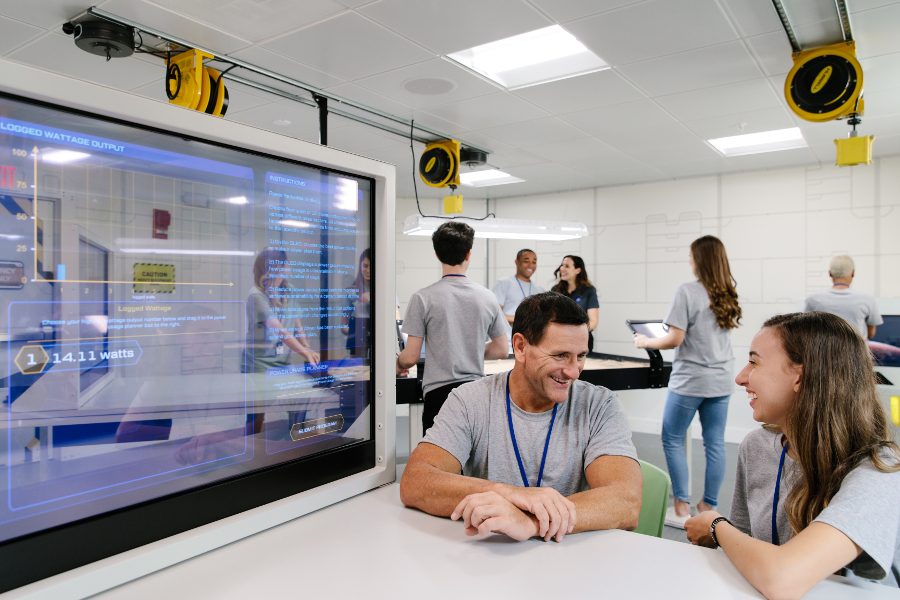
Mars Base 1
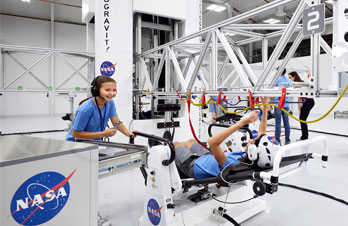
ATX Training Stages

Mars is the fourth planet from the Sun, and the seventh largest. It’s the only planet we know of inhabited entirely by robots.
All About Mars

Small World
Mars is 53% smaller than Earth.
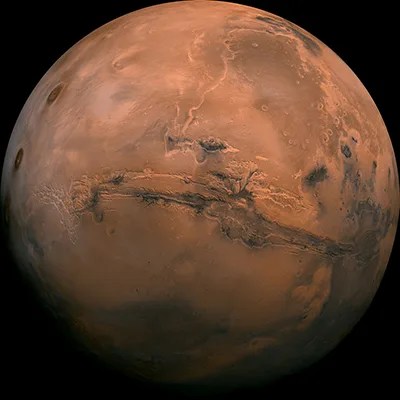
Fourth Rock
Mars is 1.52 AU from the Sun. Earth = 1.
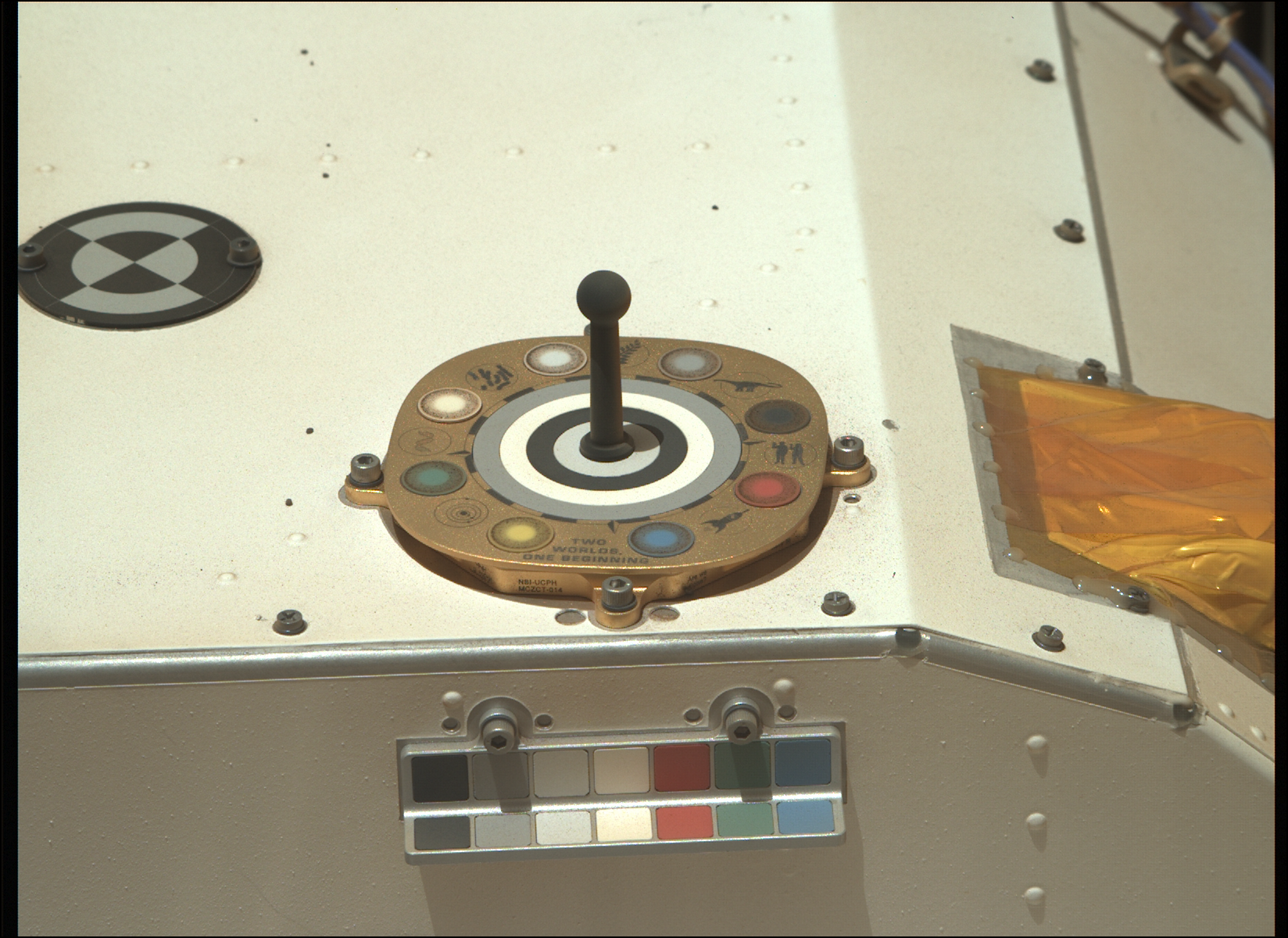
A Martian day is a little longer than Earth's; a Mars year is almost two Earth years.
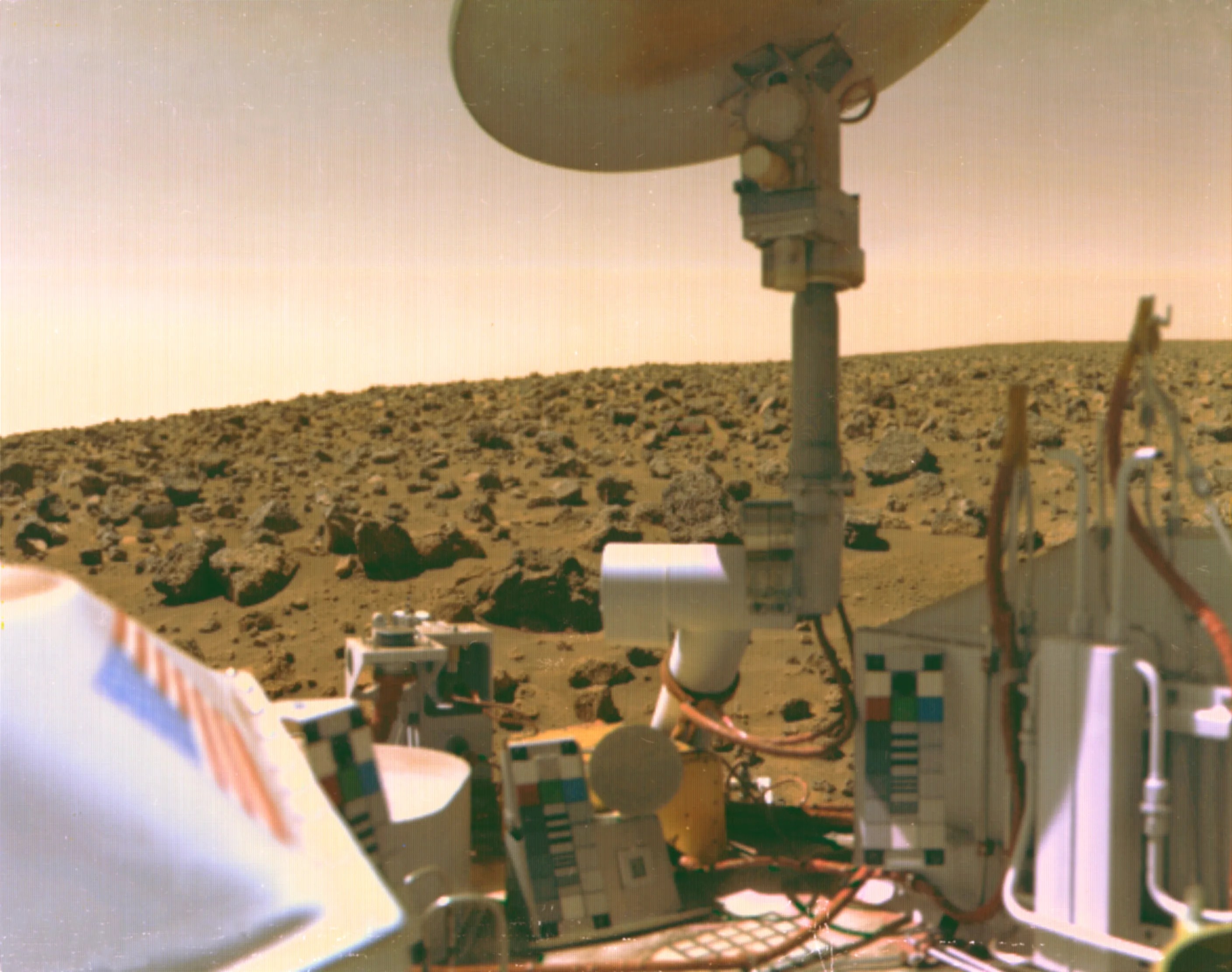
Rocky Planet
Mars' surface has been altered by volcanoes, impacts, winds, and crustal movement.
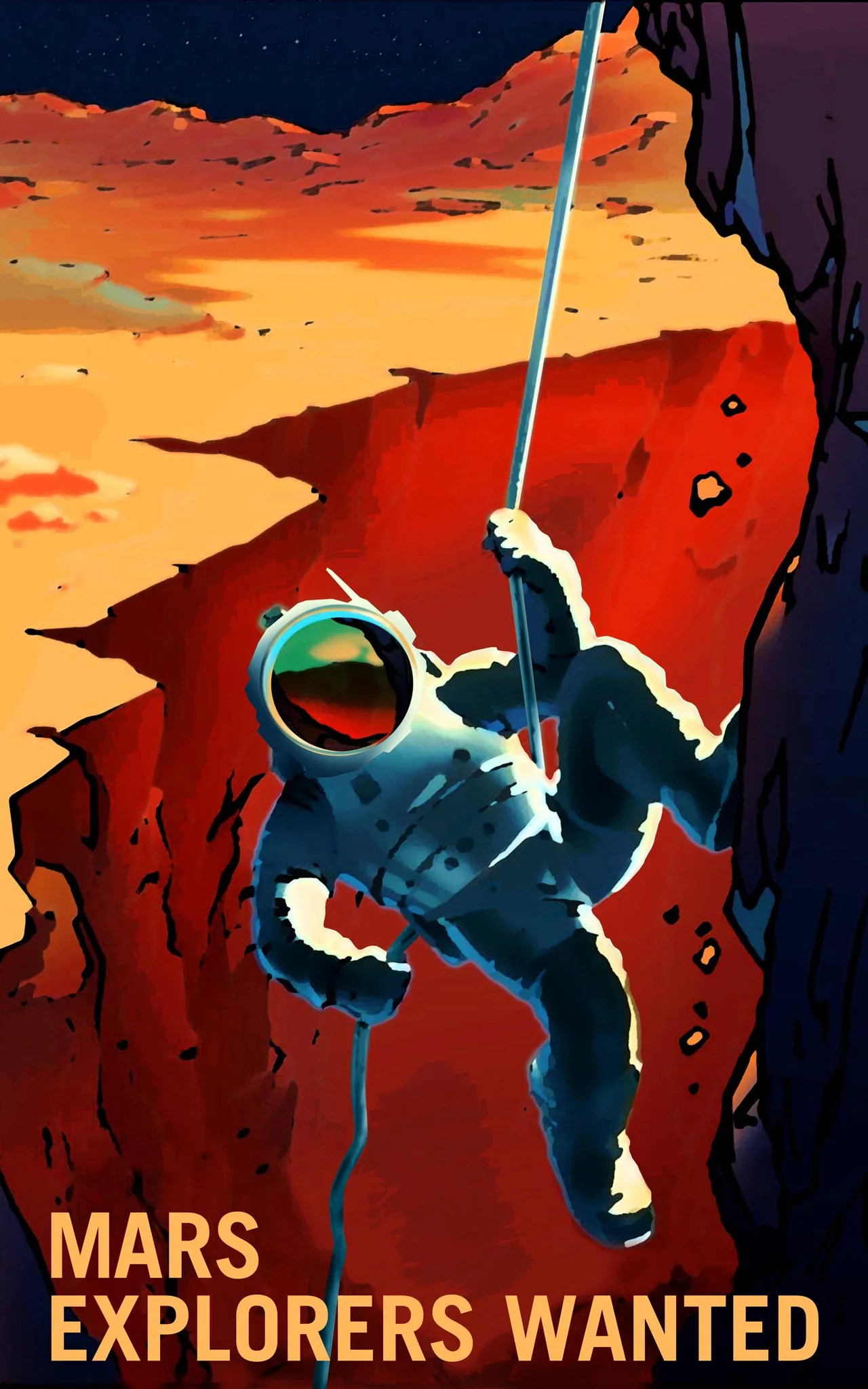
Bring a Spacesuit
Mars' atmosphere is mostly carbon dioxide, argon, and nitrogen.
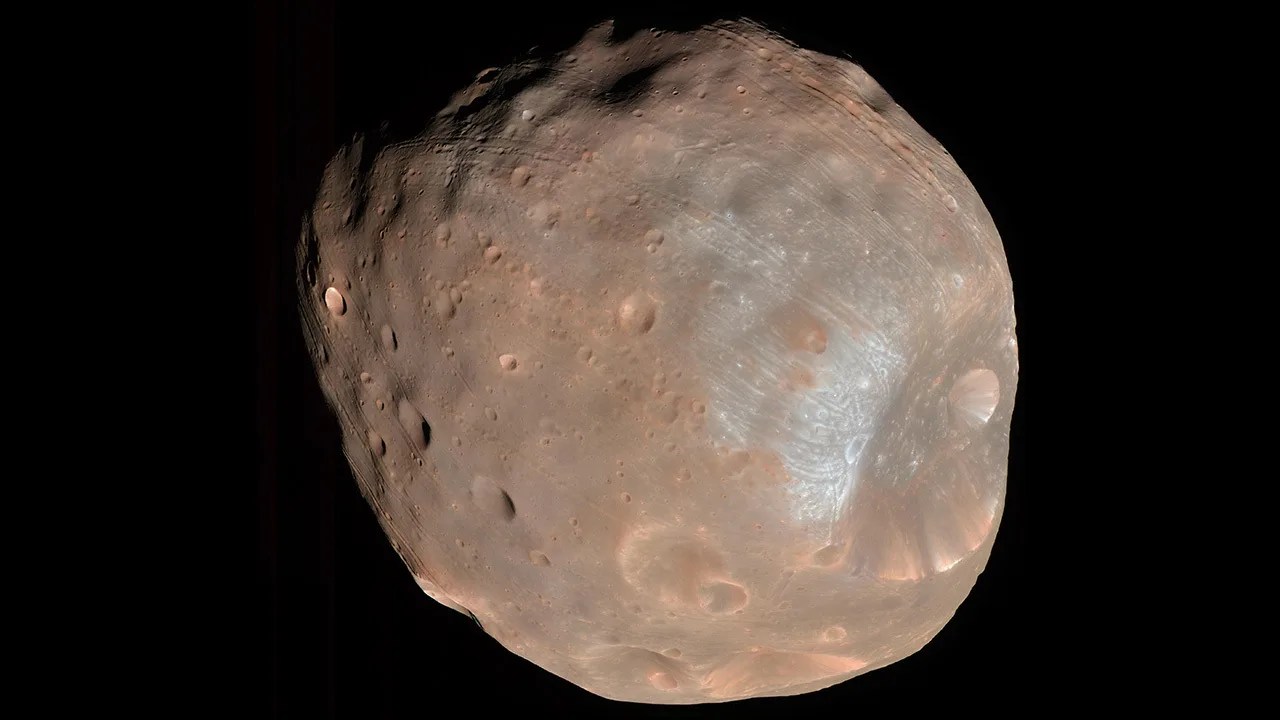
Phobos and Deimos are small compared to the planet.
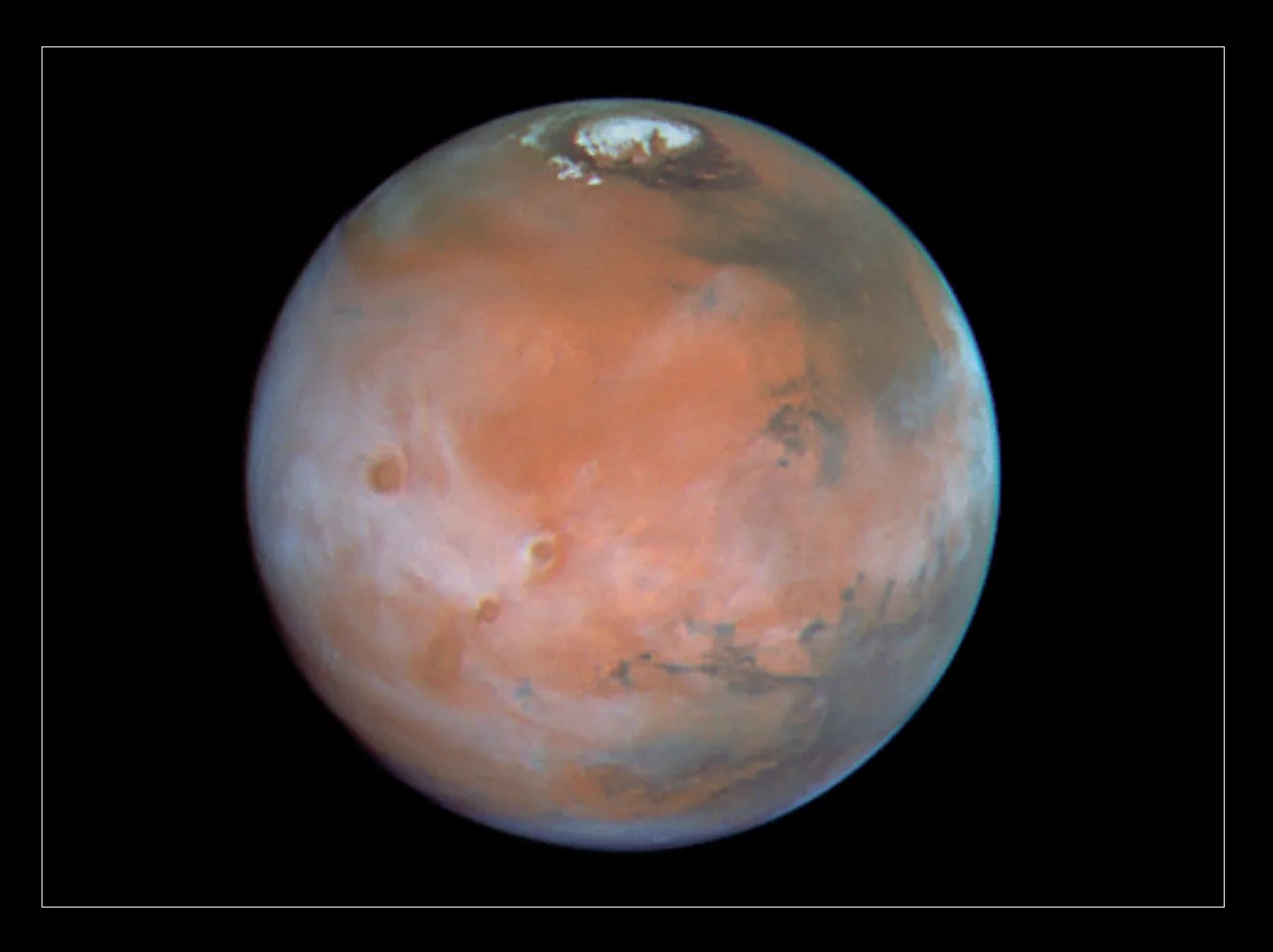
Mars has no rings.
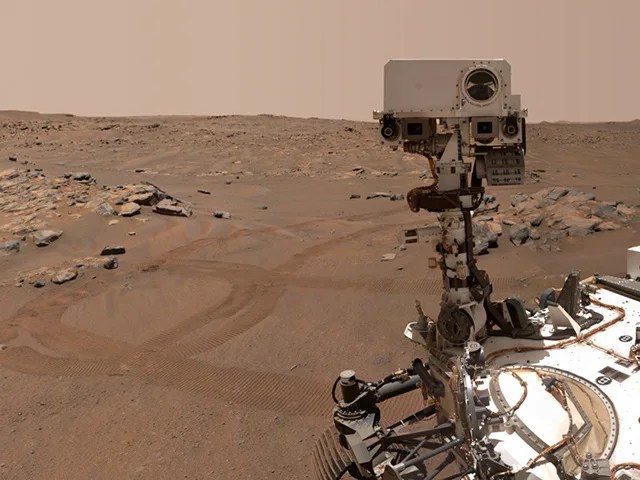
Many Missions
The first success was NASA's Mariner 4 flyby in 1965,
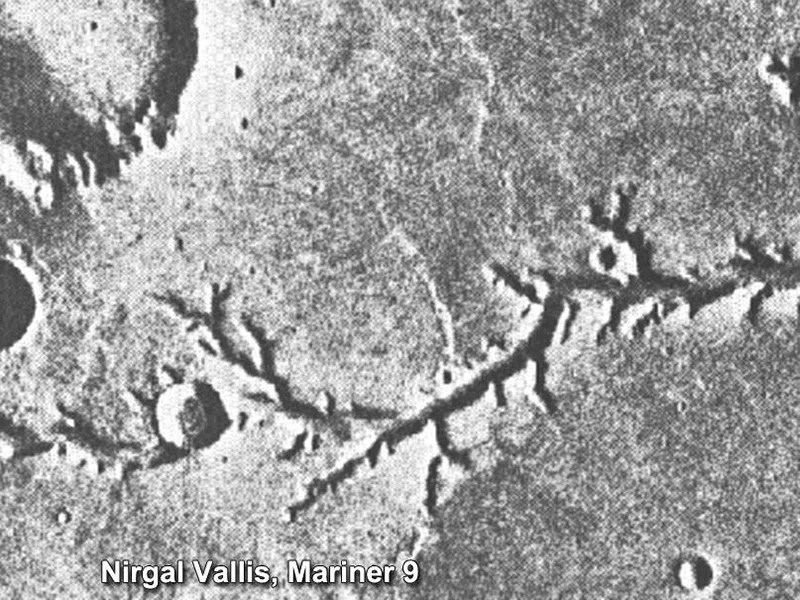
The Search for Life
Missions are determining Mars' past and future potential for life.
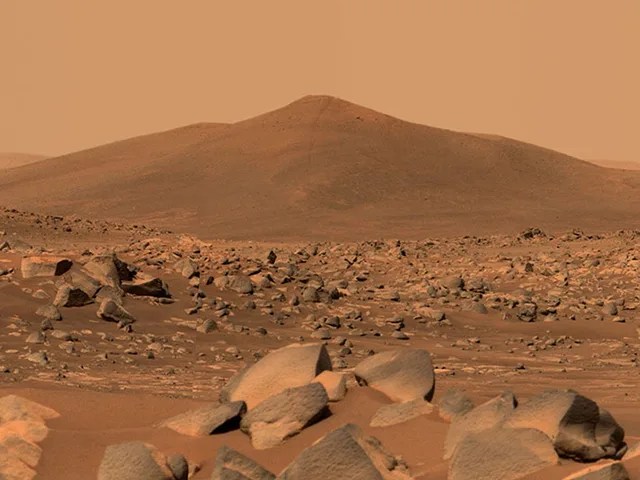
The Red Planet
Iron minerals in the Martian soil oxidize, or rust, causing the soil and atmosphere to look red.
Mars Overview
Mars is no place for the faint-hearted. It’s dry, rocky, and bitter cold. The fourth planet from the Sun, Mars, is one of Earth's two closest planetary neighbors (Venus is the other). Mars is one of the easiest planets to spot in the night sky – it looks like a bright red point of light.
Despite being inhospitable to humans, robotic explorers – like NASA's Perseverance rover – are serving as pathfinders to eventually get humans to the surface of the Red Planet.
Why Do We Go?
Mars is one of the most explored bodies in our solar system, and it's the only planet where we've sent rovers to explore the alien landscape. NASA missions have found lots of evidence that Mars was much wetter and warmer, with a thicker atmosphere, billions of years ago.
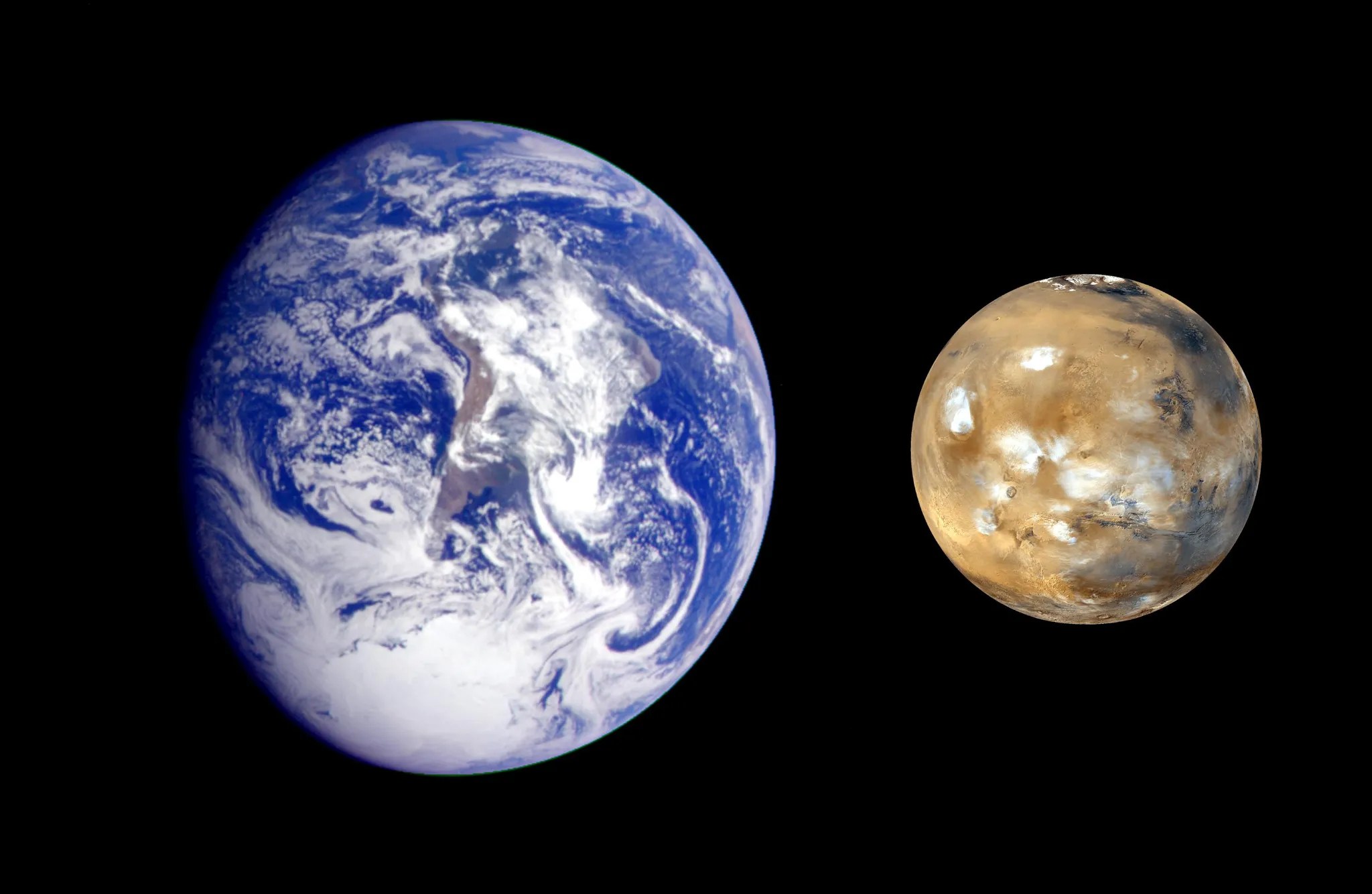
Eyes on the Solar System
How we explore.
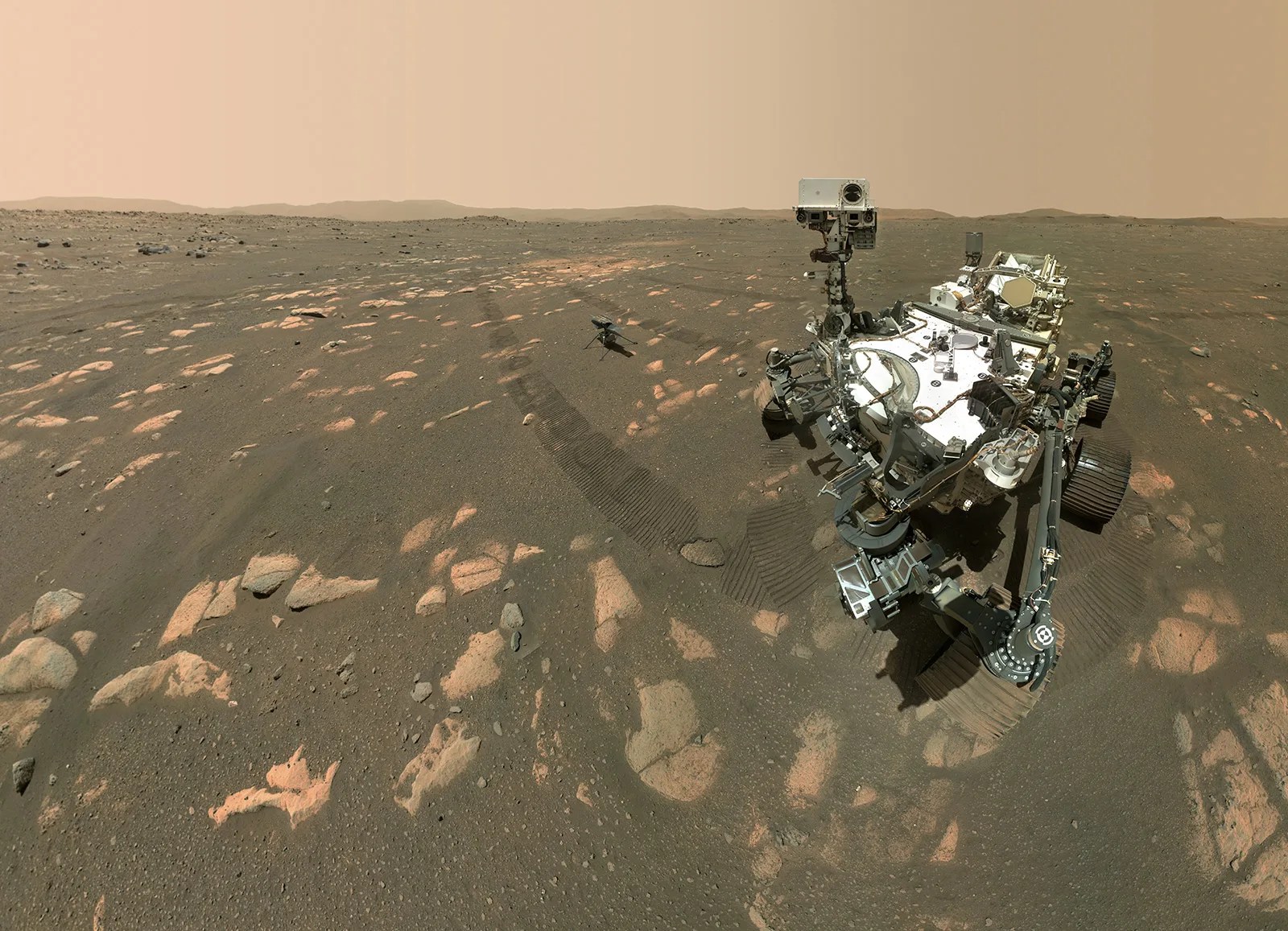
Mars 2020: Perseverance Rover
The Mars 2020 mission Perseverance rover is the first step of a proposed roundtrip journey to return Mars samples to Earth.
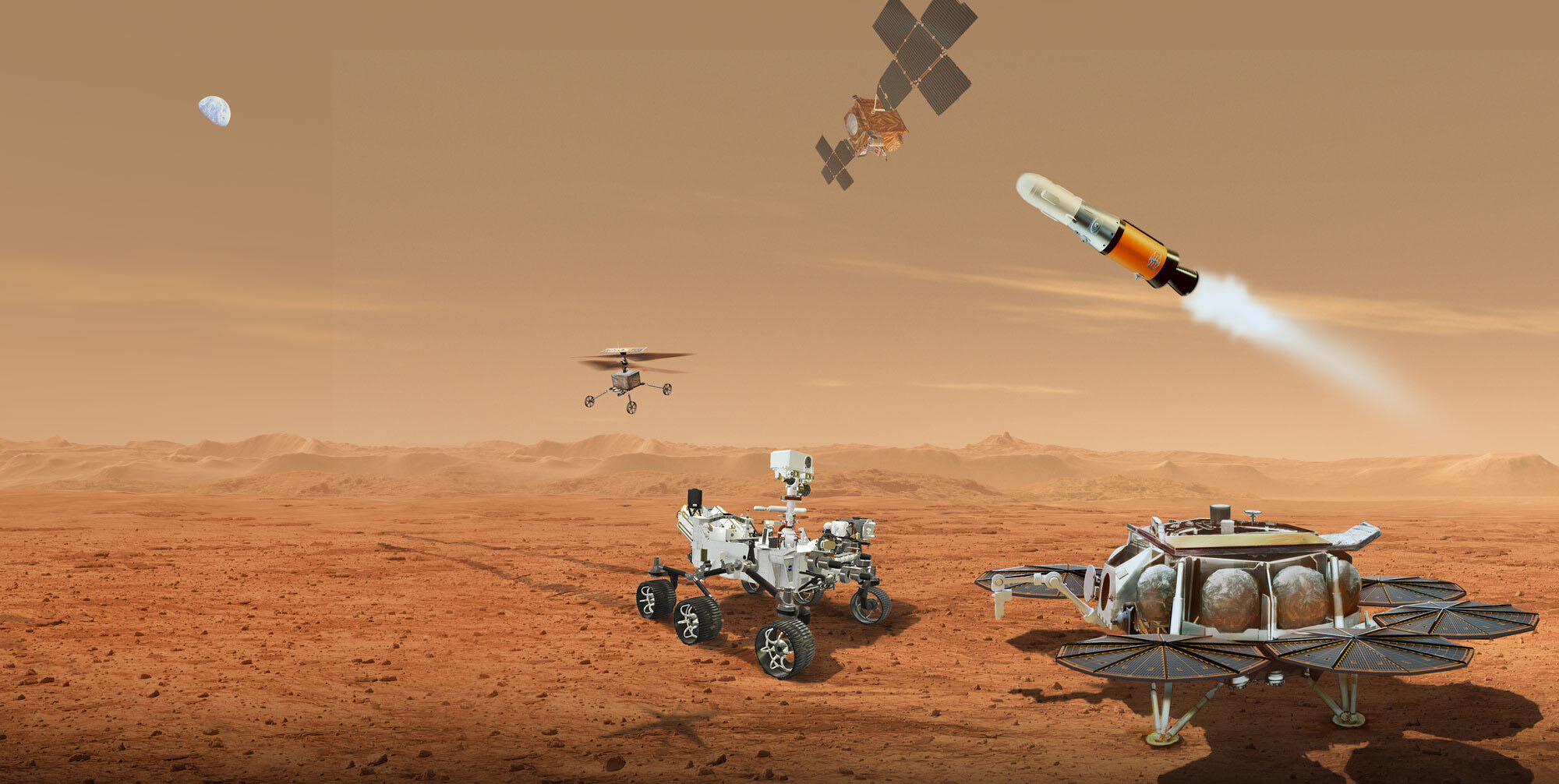
Mars Sample Return
NASA and ESA (European Space Agency) are planning ways to bring the first samples of Mars material back to Earth for detailed study.
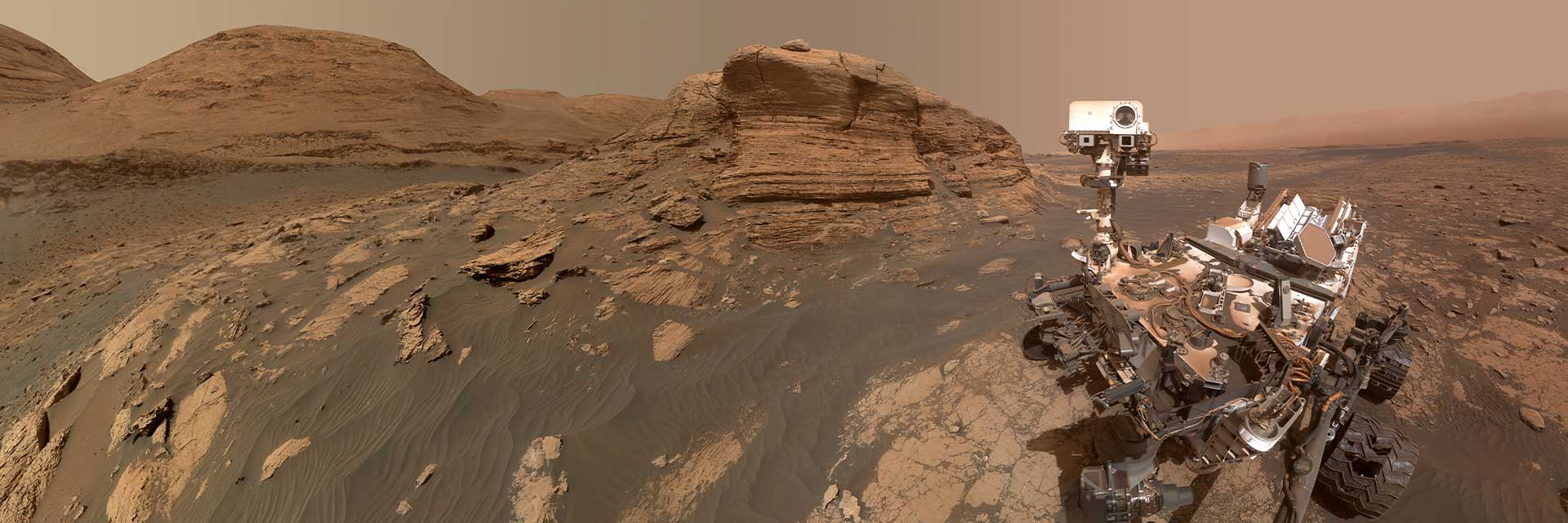
Mars Curiosity Rover (Mars Science Laboratory)
Curiosity is investigating Mars to determine whether the Red Planet was ever habitable to microbial life.
Mars Resources
View the one-stop shop for all Mars iconic images, videos, and more!
News & Features
Sols 4164-4165: What’s Around the Ridge-bend?

Sols 4161-4163: Double Contact Science

Why is Methane Seeping on Mars? NASA Scientists Have New Ideas

Sols 4159-4160: A Fully Loaded First Sol

NASA’s Ingenuity Mars Helicopter Team Says Goodbye … for Now
Beyond the Moon
Humans to mars.
Like the Moon, Mars is a rich destination for scientific discovery and a driver of technologies that will enable humans to travel and explore far from Earth.
Mars remains our horizon goal for human exploration because it is one of the only other places we know in the solar system where life may have existed. What we learn about the Red Planet will tell us more about our Earth’s past and future, and may help answer whether life exists beyond our home planet.
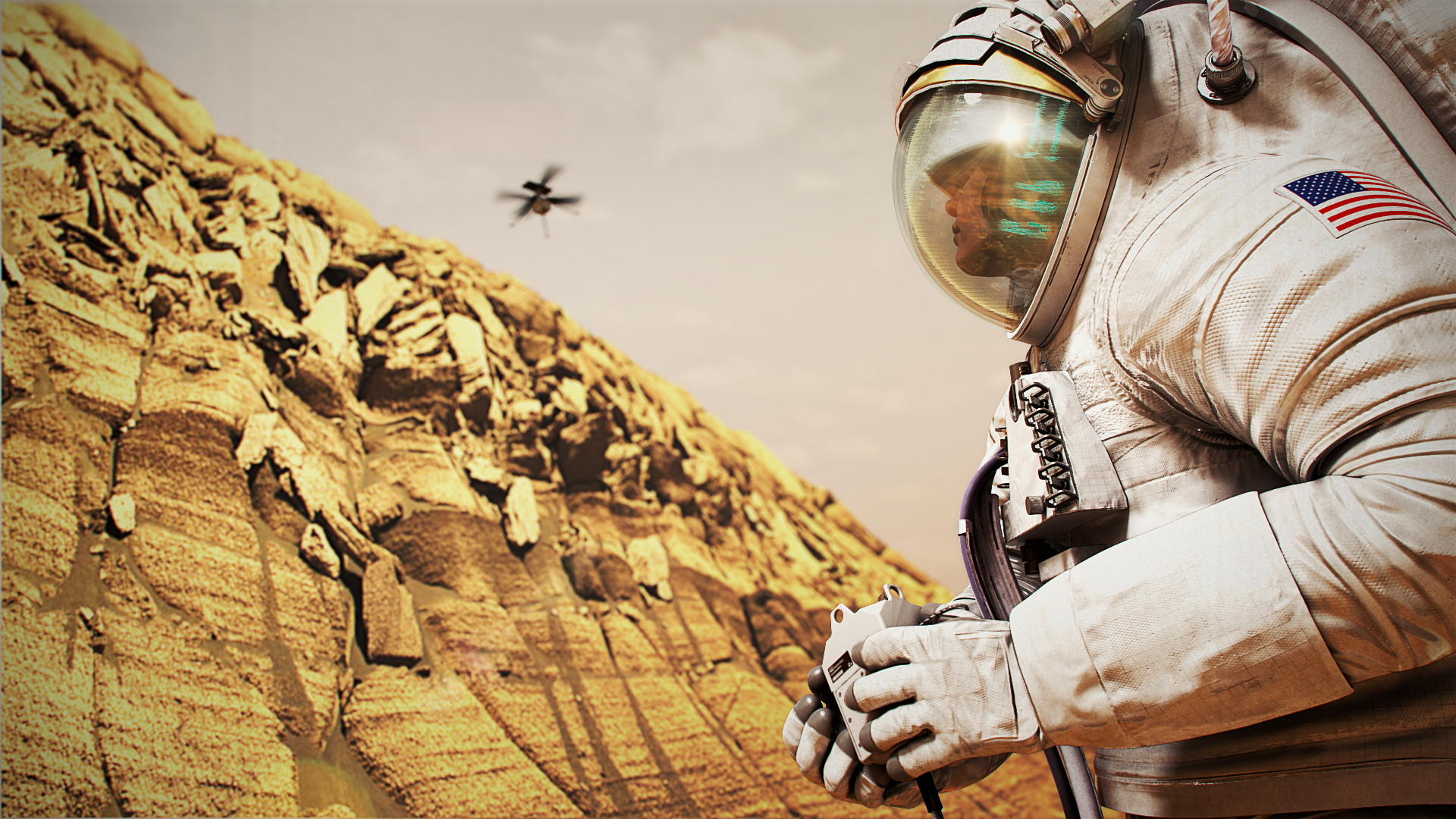
Discover More Topics From NASA


Lighting the Town Red
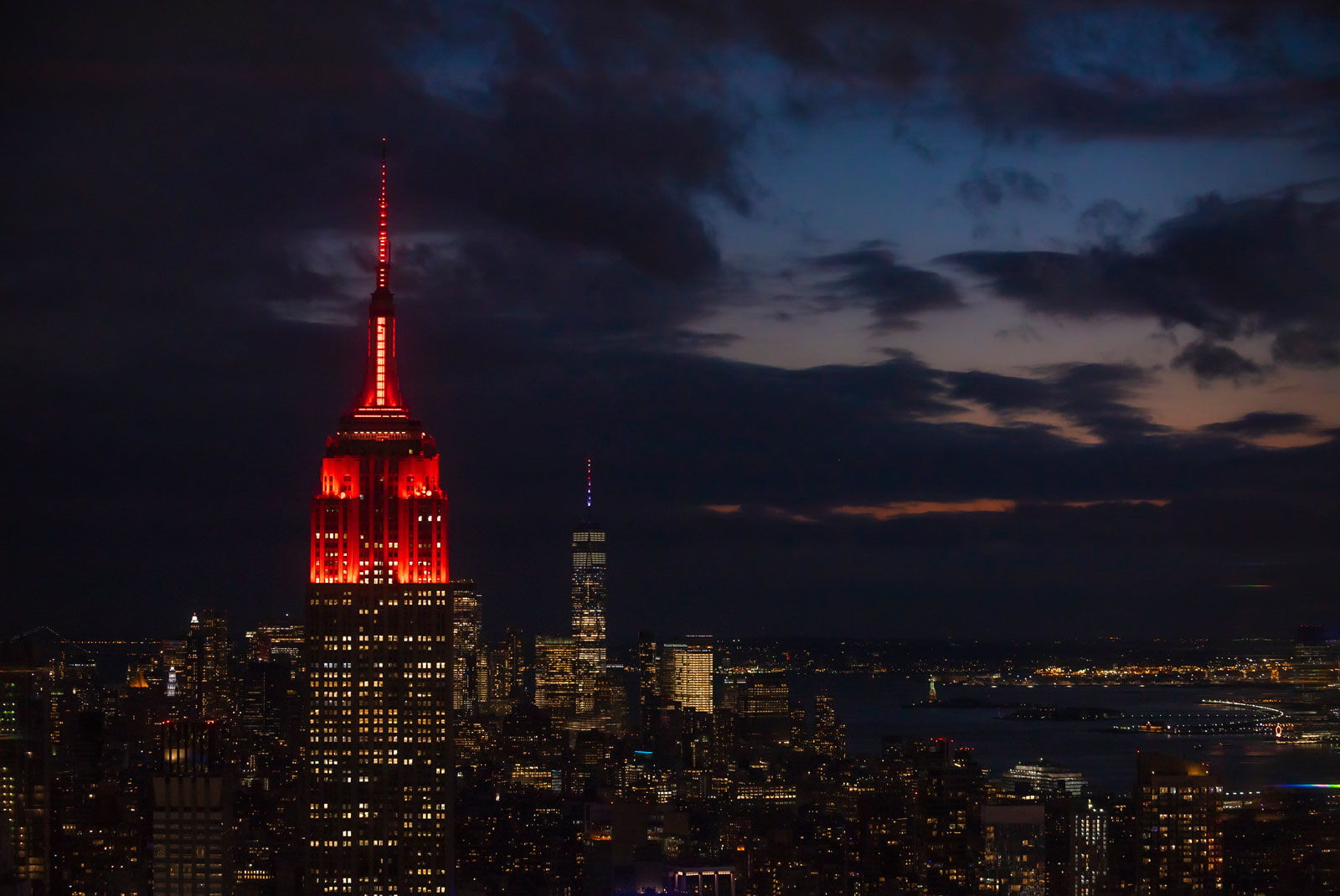
In anticipation of the targeted landing of NASA’s Perseverance rover on Feb. 18, 2021, the Empire State Building in New York began lighting its tower red on Tuesday, Feb. 16, starting at sunset.
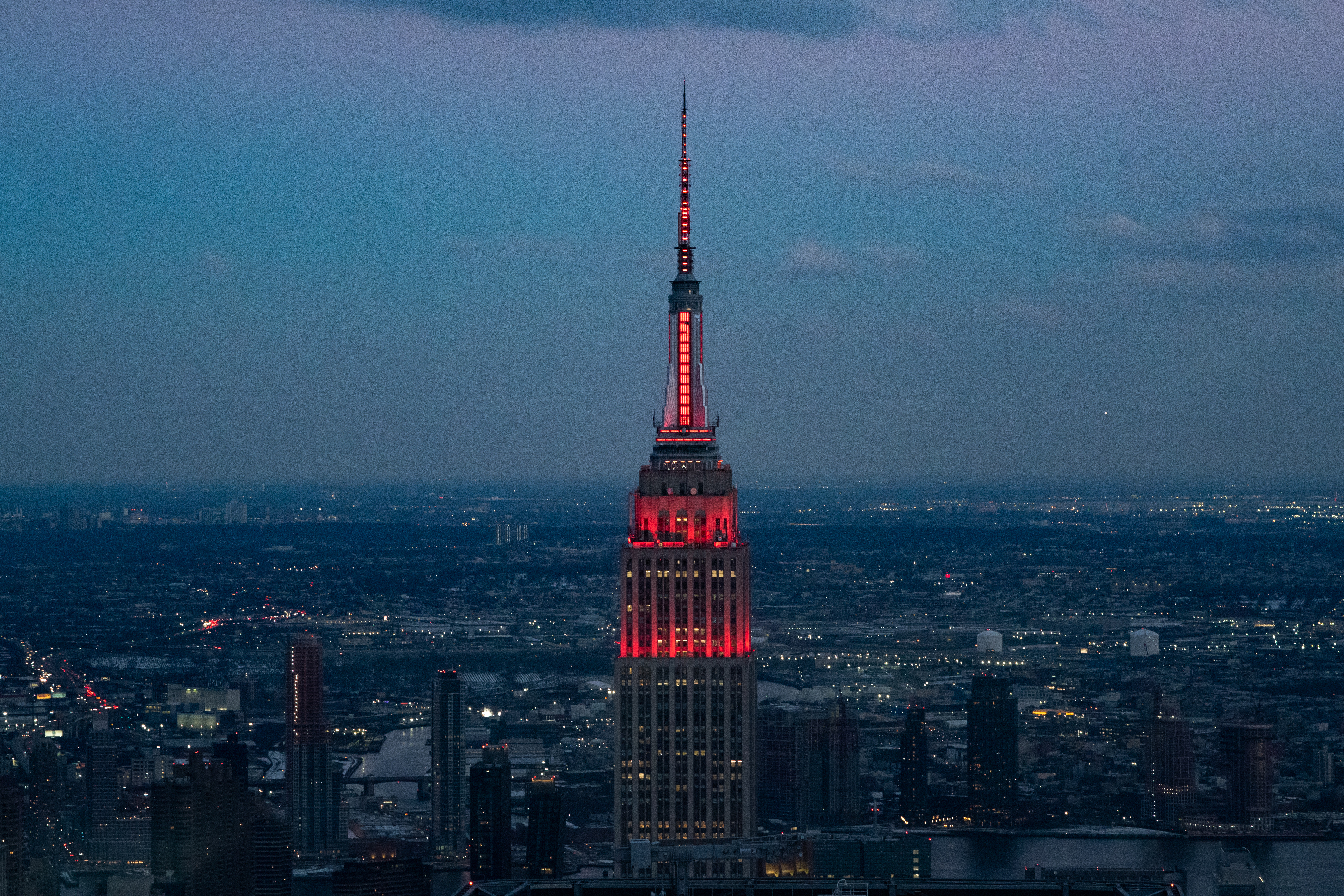
5562 x 3721
(jpg) (11.29 MB)
Watch CBS News
NASA seeking help to develop a lower-cost Mars Sample Return mission
By William Harwood
April 15, 2024 / 3:30 PM EDT / CBS News
Responding to an independent review of NASA's ambitious Mars Sample Return mission, agency officials said Monday they will seek fresh ideas from agency engineers, researchers and the private sector to come up with alternative mission designs to reign in sky-rocketing costs and get the precious samples back to Earth earlier.
The independent review board concluded last September, the complex multi-spacecraft sample return mission could cost as much as $11 billion to pull off — $4 billion to $5 billion more than originally expected — and not get samples back to Earth before 2040, even by stretching out development.
"The NASA team that looked at the Independent Review Board conclusions has said that they could string it out over time, but you're not going to get the samples back until 2040," NASA Administrator Bill Nelson told reporters. "That is unacceptable to wait that long. It's the decade of the 2040s that we're gonna be landing astronauts on Mars."
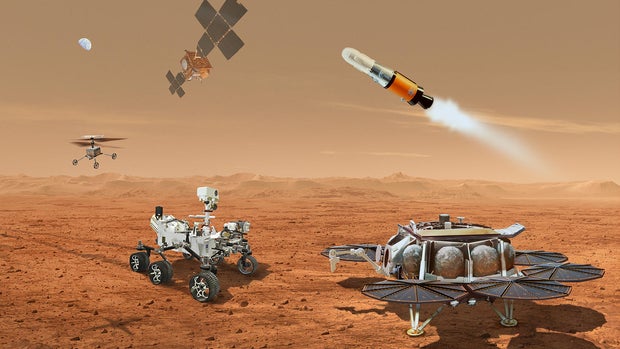
He said the estimated price tag, which could go up to $11 billion depending on the options pursued, also was "unacceptable." The original target in a National Science Foundation decadal survey that recommended a sample return mission was just under $6 billion.
"The long and short of it then is that the current budget environment doesn't allow us to pursue an $11 billion architecture, and 2040 is too long," Nelson said. "So, what to do?
"I have asked our folks to reach out with a request for information to industry, to JPL, to all NASA centers (and) to report back this fall an alternate plan that would get (samples) back quicker and cheaper, and try to stay within those limits that the decadal survey said that we should."
After the teleconference concluded, SpaceX founder Elon Musk said on X that his company's Starship rocket, which NASA Artemis astronauts will use to reach the moon's surface in the next few years, "has the potential to return serious tonnage from Mars within (about) 5 years."
Starship has the potential to return serious tonnage from Mars within ~5 years — Elon Musk (@elonmusk) April 15, 2024
No immediate comment on that idea from NASA.
As originally envisioned, the Mars Sample Return mission, or MSR, is the most complex robotic planetary science mission ever attempted, one requiring a new NASA lander to bring a rocket to the surface capable of launching soil and rock samples gathered by another rover already on the red planet.
Once in Mars orbit, the sample container would be collected by a European Space Agency spacecraft and returned to Earth for detailed laboratory analysis to determine if any signs of past microbial activity might be present in ancient riverbed deposits.
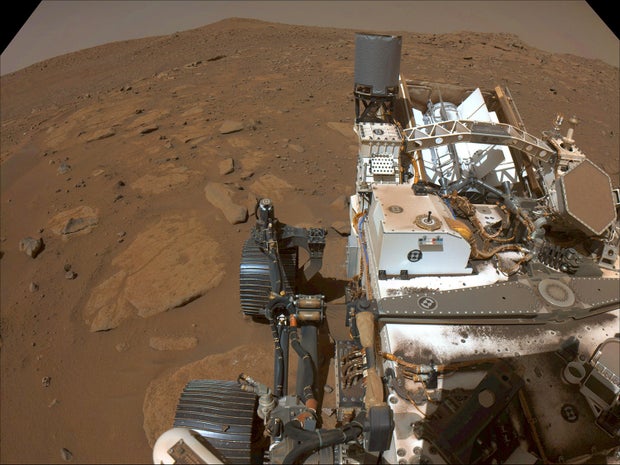
NASA originally hoped to launch the MSR mission, with a projected life cycle cost of nearly $6 billion, in 2028. But in September 2023, the independent review board concluded the project was not feasible given current budget projections, unrealistic schedules and a management structure that was not up to the task of getting the spacecraft ready for launch in time.
The review panel concluded the project almost certainly could not get off the ground before 2030 and could cost between $8.4 billion and $10.9 billion depending on the final mission architecture.
"MSR is a deep-space exploration priority for NASA, in collaboration with ESA," the review team concluded. "However, MSR was established with unrealistic budget and schedule expectations from the beginning. MSR was also organized under an unwieldy structure.
"As a result, there is currently no credible, congruent technical, nor properly margined schedule, cost and technical baseline that can be accomplished with the likely available funding."
The team said "technical issues, risks and performance-to-date indicate a near zero probability of ... meeting the 2027/2028 Launch Readiness Dates (LRDs). Potential LRDs exist in 2030, given adequate funding and timely resolution of issues."
To launch in 2030, the NASA sample retrieval lander and ESA's Earth Return Orbiter likely will requite between $8 billion and $9.6 billion, "with funding in excess of $1 (billion) per year to be required for three or more years starting in 2025."

Alternative mission scenarios and launching the sample retrieval rover and ESA orbiter on different timetables between 2030 and 2035 might "yield an MSR program that is potentially able to fit within the likely annual funding constraints." But costs could reach nearly $11 billion, more than NASA spent to build the James Webb Space Telescope.
Nelson said a major reason for the ballooning cost was a billion-dollar hit to NASA's science budget that was part of a congressional deal to secure funding for the debt ceiling. NASA received $310 million for the sample return mission in the agency's fiscal 2024 budget and plans to ask for just $200 million in the FY25 budget request while mission options are explored.
However the mission plays out, samples will be waiting. Since landing in Jezero crater in February 2021, NASA's Perseverance rover has been collecting soil and rock samples , storing them on board in sealed tubes or dropping them to the surface in known locations for eventual retrieval. The samples were collected at or near an ancient delta where water once flowed into the crater, possibly depositing indicators of past biological activity.
While Perseverance is equipped with sophisticated instruments and lab gear, it was designed primarily to assess habitability, not to look for direct signs of past microbial life . For that sort of in-depth research, the samples must be brought back to Earth.
Under the initial MSR plan, a NASA retrieval rover would touch down near the Perseverance samples, collect them with a robot arm or small helicopters and put them inside a sample container atop a solid-fuel rocket known as the Mars Ascent Vehicle. The MAV would then blast off and release the sample container in Mars orbit.
At that point, ESA's retrieval spacecraft would rendezvous with the sample spacecraft, capture it and head back to Earth. The sample container then would be released for a parachute descent to a U.S. landing site. From there, it would be flown to a laboratory at the Johnson Space Center for the start of detailed analysis.
- Perseverance Mars rover
Bill Harwood has been covering the U.S. space program full-time since 1984, first as Cape Canaveral bureau chief for United Press International and now as a consultant for CBS News.
More from CBS News
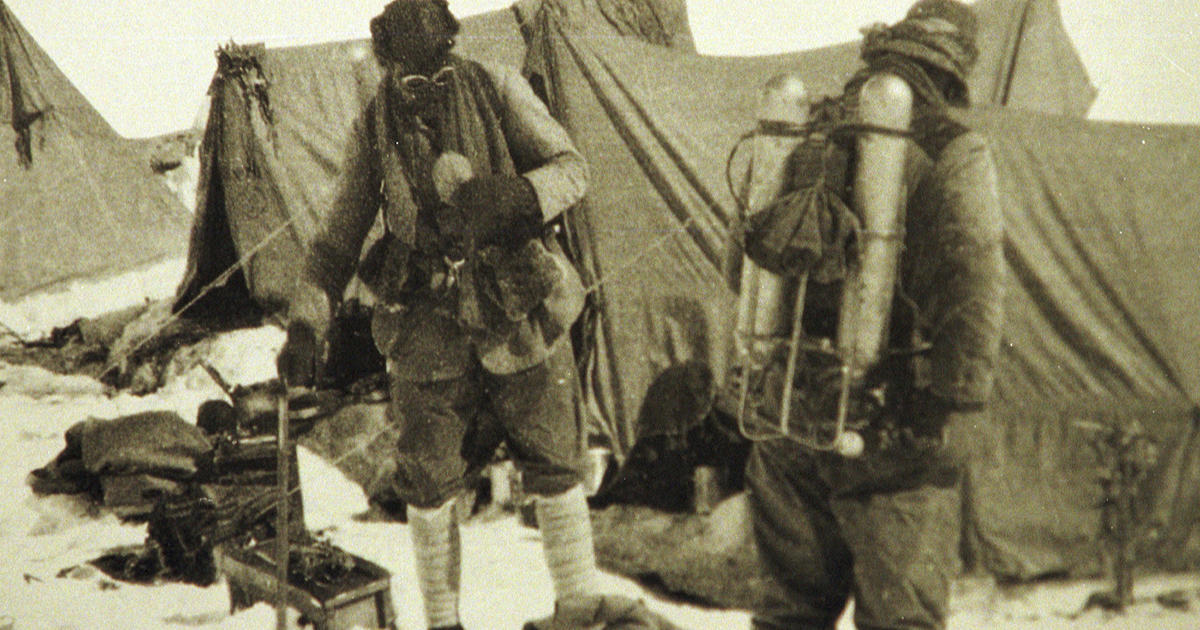
Doomed Mount Everest climber's final letter to wife revealed
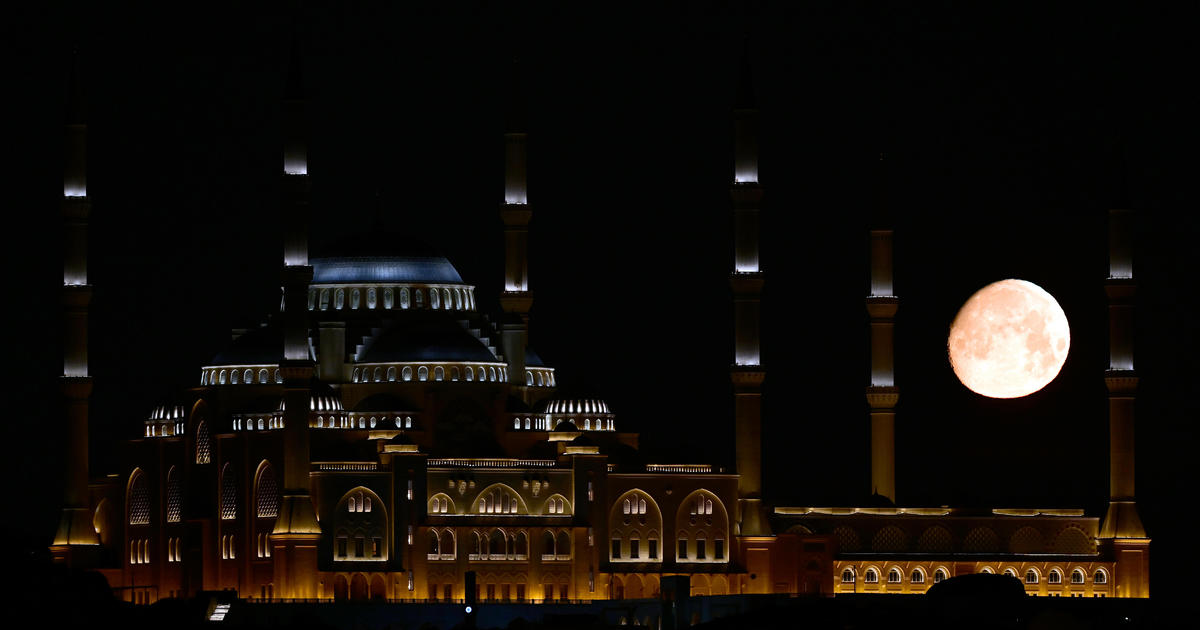
When and where you can see April's Pink Moon
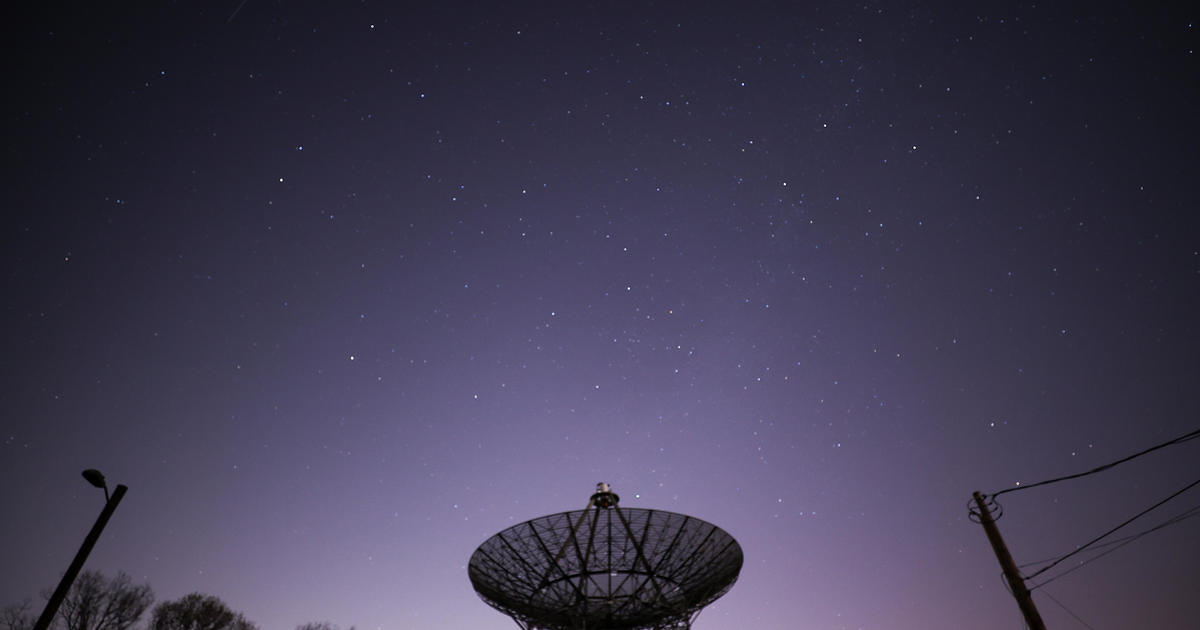
Lyrid meteor shower to peak tonight. Here's what to know
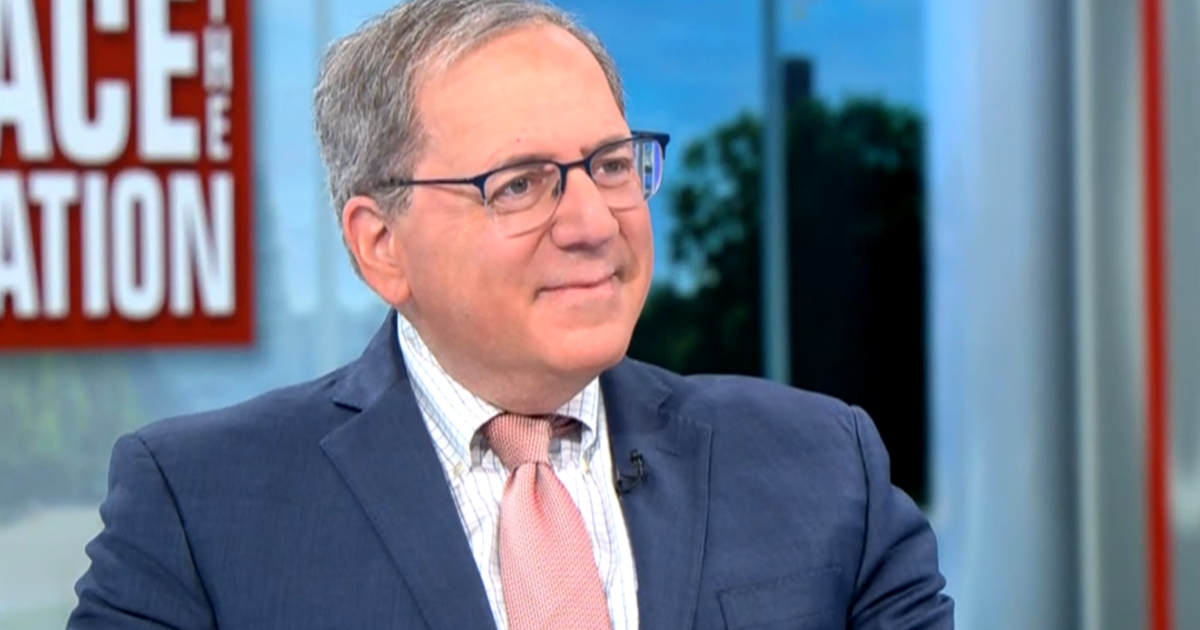
Transcript: Author David Sanger on "Face the Nation," April 21, 2024

Suggested Searches
- Climate Change
- Expedition 64
- Mars perseverance
- SpaceX Crew-2
- International Space Station
- View All Topics A-Z
Humans in Space
Earth & climate, the solar system, the universe, aeronautics, learning resources, news & events.

NASA Wins 6 Webby Awards, 8 Webby People’s Voice Awards

NASA’s CloudSat Ends Mission Peering Into the Heart of Clouds

Hubble Celebrates 34th Anniversary with a Look at the Little Dumbbell Nebula
- Search All NASA Missions
- A to Z List of Missions
- Upcoming Launches and Landings
- Spaceships and Rockets
- Communicating with Missions
- James Webb Space Telescope
- Hubble Space Telescope
- Why Go to Space
- Astronauts Home
- Commercial Space
- Destinations
Living in Space
- Explore Earth Science
- Earth, Our Planet
- Earth Science in Action
- Earth Multimedia
- Earth Science Researchers
- Pluto & Dwarf Planets
- Asteroids, Comets & Meteors
- The Kuiper Belt
- The Oort Cloud
- Skywatching
- The Search for Life in the Universe
- Black Holes
- The Big Bang
- Dark Energy & Dark Matter
- Earth Science
- Planetary Science
- Astrophysics & Space Science
- The Sun & Heliophysics
- Biological & Physical Sciences
- Lunar Science
- Citizen Science
- Astromaterials
- Aeronautics Research
- Human Space Travel Research
- Science in the Air
- NASA Aircraft
- Flight Innovation
- Supersonic Flight
- Air Traffic Solutions
- Green Aviation Tech
- Drones & You
- Technology Transfer & Spinoffs
- Space Travel Technology
- Technology Living in Space
- Manufacturing and Materials
- Science Instruments
- For Kids and Students
- For Educators
- For Colleges and Universities
- For Professionals
- Science for Everyone
- Requests for Exhibits, Artifacts, or Speakers
- STEM Engagement at NASA
- NASA's Impacts
- Centers and Facilities
- Directorates
- Organizations
- People of NASA
- Internships
- Our History
- Doing Business with NASA
- Get Involved
- Aeronáutica
- Ciencias Terrestres
- Sistema Solar
- All NASA News
- Video Series on NASA+
- Newsletters
- Social Media
- Media Resources
- Upcoming Launches & Landings
- Virtual Events
- Sounds and Ringtones
- Interactives
- STEM Multimedia

Dr. Douglas Hudgins

Sols 4164-4165: What’s Around the Ridge-bend?

First NASA Mars Analog Crew Nears End of Mission

Work Underway on Large Cargo Landers for NASA’s Artemis Moon Missions

NASA Open Science Initiative Expands OpenET Across Amazon Basin

NASA Motion Sickness Study Volunteers Needed!

Amendment 11: Physical Oceanography not solicited in ROSES-2024

NASA Data Helps Beavers Build Back Streams

Sols 4161-4163: Double Contact Science

Why is Methane Seeping on Mars? NASA Scientists Have New Ideas

Explore the Universe with the First E-Book from NASA’s Fermi

Hubble Captures a Bright Galactic and Stellar Duo

NASA Photographer Honored for Thrilling Inverted In-Flight Image

NASA’s Ingenuity Mars Helicopter Team Says Goodbye … for Now

NASA Langley Team to Study Weather During Eclipse Using Uncrewed Vehicles

NASA’s Near Space Network Enables PACE Climate Mission to ‘Phone Home’

Amendment 10: B.9 Heliophysics Low-Cost Access to Space Final Text and Proposal Due Date.

Students Celebrate Rockets, Environment at NASA’s Kennedy Space Center

My NASA Data Milestones: Eclipsed by the Eclipse!
Earth Day 2024: Posters and Virtual Backgrounds

Diez maneras en que los estudiantes pueden prepararse para ser astronautas

Astronauta de la NASA Marcos Berríos

Resultados científicos revolucionarios en la estación espacial de 2023
Nasa selects new crew for next simulated mars journey.
Nathan Cranford
Primary crew, alternate crew, complementary analog missions.

NASA has selected a new crew of four volunteers to participate in a simulated mission to Mars within a habitat at the agency’s Johnson Space Center in Houston.
Jason Lee, Stephanie Navarro, Shareef Al Romaithi, and Piyumi Wijesekara will step into the agency’s Human Exploration Research Analog, or HERA , on Friday, May 10. Once inside, the team will live and work like astronauts for 45 days. The crew will exit the facility on June 24 after they “return” to Earth. Jose Baca and Brandon Kent are this mission’s alternate crew members.
HERA enables scientists to study how crew members adapt to isolation, confinement, and remote conditions before NASA sends astronauts on deep space missions to the Moon, Mars, and beyond. Crew members will carry out scientific research and operational tasks throughout their simulated mission to the Red Planet, including a “walk” on Mars’s surface using virtual reality. They will also experience increasing communication delays lasting up to five minutes each way with Mission Control Center as they “near” Mars.
This crew is the second group of volunteers to participate in a simulated Mars mission in HERA this year. The most recent crew completed its HERA mission on March 18. Two other missions will follow this year, with the final HERA crew slated to wrap up on Dec. 20.
In a first for HERA, one crew member, Shareef Al Romaithi, hails from the United Arab Emirates (UAE) and will participate in the mission through a partnership between NASA and the UAE’s Mohammed Bin Rashid Space Centre (MBRSC).
As with the previous HERA mission this year, NASA’s Human Research Program is conducting 18 human health studies during the mission. The experiments will evaluate the physiological, behavioral, and psychological responses of crew members in an environment similar to what astronauts will face on a trip to Mars. Seven of these studies are collaborations with the MBRSC and the European Space Agency (ESA). Insights gleaned from the studies will allow researchers to develop and test strategies aimed at helping astronauts overcome obstacles on long missions deep into space.
The primary crew of the upcoming mission is:

Lee holds a bachelor’s degree in Mechanical Engineering from the University of California, Berkeley and master’s and doctorate degrees in Mechanical Engineering from the University of Texas at Austin. His graduate research focused on manufacturing processes involving heat transfer and the characterization of heat shielding materials. He completed a postdoctoral degree at the Massachusetts Institute of Technology, Cambridge, studying high-strength nanofibers.
Lee lives in Boston. In his spare time, he enjoys running, martial arts, chess, and indoor rock climbing. He also likes to watch movies and plays, try new cuisines, spend time with friends, and visit his nephew and nieces.
Stephanie Navarro

Navarro earned her bachelor’s degree in Physics from the University of Central Florida in Orlando. While pursuing her undergraduate studies, she served the constituents of Florida as a congressional intern for both the U.S. House and Senate. She recently completed a model-based systems engineering certificate program from the California Institute of Technology, Pasadena, and is working toward a master’s degree in Cybersecurity from the University of Maryland Global Campus.
Born and raised by Ecuadorian parents in Miami, Navarro has strong ties to her cultural heritage. She enjoys spending time with her family, traveling the world, studying for her pilot’s license, and immersing herself in various culinary experiences. During her spare time, she is either working out, at the beach, or in the air flying a Cessna 172. She lives in Orlando, Florida.
Shareef Al Romaithi

Al Romaithi received a bachelor’s degree in Aerospace Engineering and three master’s degrees from Embry-Riddle Aeronautical University, focusing on aerospace and aviation management, safety systems, and space operations, respectively. He went on to earn a doctorate degree in Aviation from Embry-Riddle Aeronautical University in 2014, specializing in safety systems and human factors. These degrees were based at the university’s Dayton Beach campus, except for the master’s focusing on space operations, which was from the university’s worldwide campus. He is the world’s youngest and eighth graduate to attain a doctorate degree in aviation.
Al Romaithi currently lives in Abu Dhabi, UAE. He joins HERA through a partnership between NASA and MBRSC. In his free time, he enjoys fishing, reading, and traveling.
Piyumi Wijesekara

Wijesekara earned her bachelor’s degree in Bioengineering from the University of California, San Diego, and her master’s and doctorate degrees in Biomedical Engineering from Carnegie Mellon University in Pittsburgh, Penn. Her doctoral research focused on stem cell and organ engineering, with an emphasis on engineering lung models that mimic human lung physiology, to study respiratory diseases.
Wijesekara currently lives in San Francisco. She enjoys spending time with family and friends, running along the San Francisco Bay, reading, hiking, volunteering at the food pantry, and attending concerts and musicals.

Baca received a bachelor’s degree in Electrical Engineering from the Instituto Tecnologico de Matamoros in Mexico. He then earned a master’s degree in Mechatronics from the University of Applied Science of Aachen, Germany, and a doctorate degree in Automation and Robotics from the Universidad Politecnica in Madrid, Spain.
Baca went on to work as a postdoctoral researcher in the computer science department at the University of Nebraska at Omaha. There, he became involved in a research project funded by NASA that sought to develop a reconfigurable robotic system capable of transforming itself to overcome obstacles and explore unknown scenarios. Through this work, he also began undertaking projects aimed at supporting astronauts during long-duration space missions.
In his free time, Baca promotes science, technology, engineering, and math activities for students in elementary school through college, with a particular focus on engineering and robotics. He lives in Corpus Christi, Texas and enjoys exercising, exploring new places, experiencing new cultures and cuisines, and spending time with family.
Brandon Kent

Kent holds bachelor’s degrees in both Biochemistry and Biology from North Carolina State University in Raleigh. He earned his doctorate in Biomedicine from Mount Sinai School of Medicine in New York City, where his work primarily focused on how genetic factors regulate early embryonic development and cancer development.
Following graduate school, Kent moved into scientific and medical communications consulting in oncology, with a primary focus on clinical trial data disclosures, scientific exchange, and medical education initiatives.
Kent and his wife have two daughters. In his spare time, he enjoys spending time with his daughters, flying private aircraft, hiking, staying physically fit, and reading. He lives in Kinnelon, New Jersey.
In addition to HERA, NASA’s Crew Health and Performance Exploration Analog (CHAPEA ), a series of analog missions that will simulate year-long stays on the surface of Mars, is informing the agency’s efforts in preparing for future human Mars missions.
HERA and CHAPEA complement each other by assessing human health and performance in isolated and confined conditions that simulate spaceflight operations in the remote exploration environments of the Moon and Mars, including communication delays and environmental stressors. Both analogs collect data on humans living and working in separate habitats at NASA Johnson.
NASA’s Human Research Program
NASA’s Human Research Program , or HRP, pursues the best methods and technologies to support safe, productive human space travel. Through science conducted in laboratories, ground-based analogs, and the International Space Station, HRP scrutinizes how spaceflight affects human bodies and behaviors. Such research drives HRP’s quest to innovate ways that keep astronauts healthy and mission-ready as space travel expands to the Moon, Mars, and beyond.
Explore More

NASA Shares Medical Expertise with New Space Station Partners
Discover more topics from nasa.
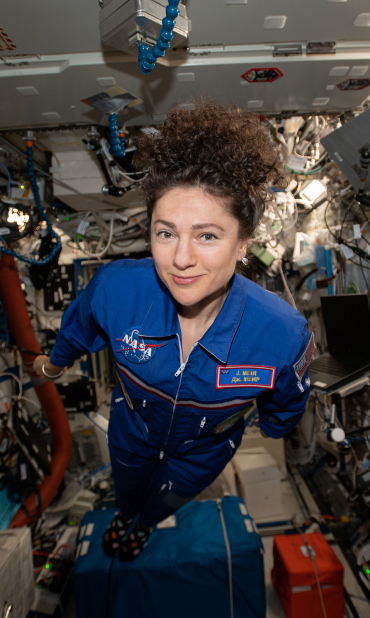
Human Research Program

Space Station Research and Technology


IMAGES
VIDEO
COMMENTS
NASA Tram Tours are the most popular experiences at Space Center Houston - add them to your visit! These tours are your chance to go on-site at NASA Johnson Space Center (JSC) and get an up-close look at human space exploration.. Located on 1,600 acres, NASA Johnson Space Center is the training base for NASA astronauts and the site of Mission Control, where a Houston-based team supports the ...
Commercial Crew Program 360-Degree Virtual Reality Tour : NASA's Commercial Crew Program works with commercial partners to launch astronauts to the International Space Station from U.S. soil on American-built rockets and spacecraft. These immersive videos share the story of groundbreaking innovation borne of this government-industry partnership.
Must be 14 years of age or older - Includes general admission. Select Date/Time. $199.95. NASA VIP Tour - Astronaut Training. Must be 14 years of age or older - Includes general admission. $199.95. Breakfast with an Astronaut. Enhance your Space Center Houston experience with Breakfast with an Astronaut, our ultimate astronaut opportunity ...
The standard entry ticket gets you access to all the exhibits in the Space Center as well as the tram tour of NASA Johnson Space Center. This is the ticket included on the Houston City PASS. This costs $29.95 - $34.95 for an adult. The standard entry ticket with Mission control tour. This is the same as the standard entry ticket but it also ...
NASA's Marshall Space Flight Center is situated on the U.S. Army's Redstone Arsenal in Huntsville, Alabama. ... The Marshall Space Flight Center bus tour is temporarily suspended. U.S. Space & Rocket Center bus tours of Marshall are $20 for guests ages 5 and up. Children 4 and under ride free. For more information, ...
Immerse yourself in the science of current missions to the International Space Station (ISS) and upcoming missions to explore deep space. Travel to the Red Planet in Journey to Mars: Explorers Wanted. Right now, NASA missions are paving the way for what's next for the future of space exploration. Mission Zone Overview.
January 30, 2024 By CityPASS. The NASA Tram Tour at Space Center Houston offers an unparalleled glimpse into the heart of human spaceflight. A must-visit for anyone intrigued by the mysteries of space, the tour is an immersive experience that brings the cosmos closer to Earth. Visitors can anticipate a day filled with awe as they explore unique ...
Onsite Tours. The JPL Public Services Office offers a limited number of onsite, in-person tours, free of charge, for groups and individuals on an advance reservation basis. Visitor parking is also available free of charge. All tours commonly include a multimedia presentation on JPL entitled "Journey to the Planets and Beyond," which provides an ...
Red Planet. On this thrilling journey to Mars, witness the Red Planet's rugged beauty firsthand. Featuring a glimpse back in time at Mars' ancient oceans, an encounter with the pioneering Perseverance rover, and an escape from one of the planet's infamous dust storms, this tour offers an up-close look at our planetary neighbor's history and potential.
Planets Take Virtual Shape on Earth with NASA Knowledge and Imagery. In a time of quarantines and online learning, guided strolls along the surface of Mars are especially appealing. These tours are possible with Access Mars, a free virtual reality experience of the Red Planet, with interactive landmarks and narration by a NASA scientist, using ...
U.S. Space & Rocket Center. One Tranquility Base. Huntsville, AL 35805. (256) 837-3400. 1-800-637-7223. (256)721-7114. General Admission to the U.S. Space & Rocket Center includes access to the Saturn V Hall, Moon Crater, Military Park, Rocket Park, Shuttle Park, Spark!Lab, ISS: Science on Orbit, and available featured exhibit (s), activities ...
A NASA's Perseverance Mars rover took this selfie over a rock nicknamed "Rochette," on Sept. 10, 2021, the 198th Martian day, or sol of the mission. A life-size model of the rover will be rolling across the country as part of the "Roving With Perseverance" tour. Credits: NASA/JPL-Caltech/MSSS. Catch Mars mania as a traveling exhibit ...
As the world watched the outcome of Apollo 11, the first attempted lunar landing, employees in the NASA Mission Control Center held their breaths during the entire descent. Everyone anxiously awaited the confirmation of a safe arrival from its Apollo crew.At approximately 3:18 p.m. (CT) on July 20, 1969, Neil Armstrong's famous words were forever […]
At Kennedy Space Center, get up close to space shuttle Atlantis, travel to the Red Planet or see a rocket launch, all just one hour from Orlando. ... Behind the Gates Kennedy Space Center Bus Tour Race to the Moon Apollo Moon ... Kennedy Space Center Visitor Complex is operated for NASA by Delaware North and is entirely visitor-funded. ...
From its vantage point high above Earth's atmosphere, NASA's Hubble Space Telescope has completed this year's grand tour of the outer solar system - returning crisp images that complement current and past observations from interplanetary spacecraft. This is the realm of the giant planets - Jupiter, Saturn, Uranus, and Neptune - extending as far as […]
Blue team tour covers Saturn V rocket park and mission control (either old one for Apollo program or new one for ISS) One tram tour is approximate 100 minute. Red tram is mostly like fit for teenages . If you have enough time in NASA, better to try both tram tours. Hopefully, this will help you and your kids.
Exploring the Moon. Race To The Moon. Experience the wonder of the Apollo Moon landings through various interactive exhibits and artifacts. Seeing a real lunar module and touching an actual Moon rock are only a few of the ways you too can explore the Moon! Included With Admission.
NASA missions have found lots of evidence that Mars was much wetter and warmer, with a thicker atmosphere, billions of years ago. Explore with Us Earth-Mars Comparison: This composite image, from NASA Galileo and Mars Global Survey orbiters, of Earth and Mars was created to allow viewers to gain a better understanding of the relative sizes of ...
NASA Glenn will host an in-person tour season this year. In-person tours will be held on the following dates: April 29, May 20, Aug. 12 (rescheduled), Sept. 23, Oct. 7, and Nov. 4. Two virtual tours will be offered this year. Dates are yet to be determined. Check Glenn's Tour Page for updates.
In anticipation of the targeted landing of NASA's Perseverance rover on Feb. 18, 2021, the Empire State Building in New York began lighting its tower red on Tuesday, Feb. 16, starting at sunset.
Tours of NASA's Wallops Flight Facility are only provided to non-profit, school, and civic groups of 8-20 people. Groups are required to provide a single vehicle large enough to transport the entire group plus a Visitor Center Tour Guide. Minimum age for tour groups is 12, but most tour content is better suited for adult groups. These behind ...
NASA received $310 million for the sample return mission in the agency's fiscal 2024 budget and plans to ask for just $200 million in the FY25 budget request while mission options are explored.
NASA has selected a new crew of four volunteers to participate in a simulated mission to Mars within a habitat at the agency's Johnson Space Center in Houston.. Jason Lee, Stephanie Navarro, Shareef Al Romaithi, and Piyumi Wijesekara will step into the agency's Human Exploration Research Analog, or HERA, on Friday, May 10.Once inside, the team will live and work like astronauts for 45 days.